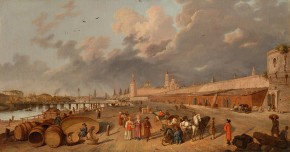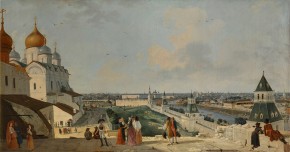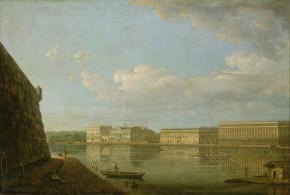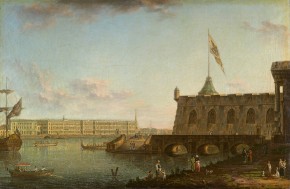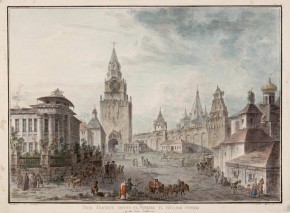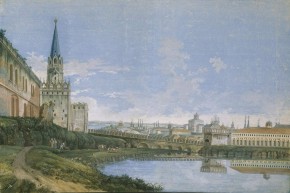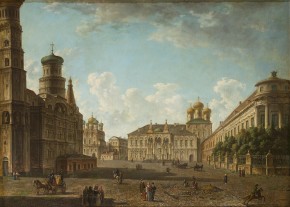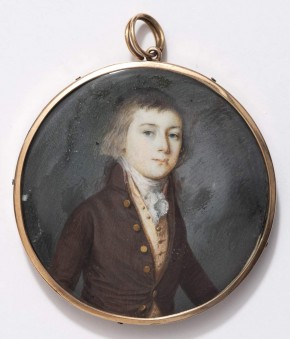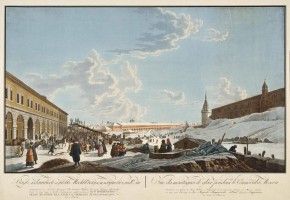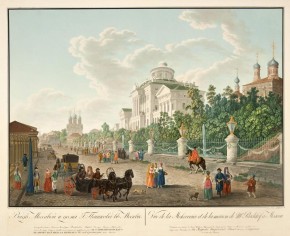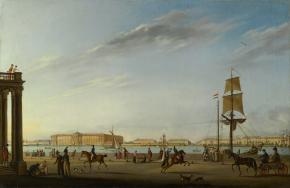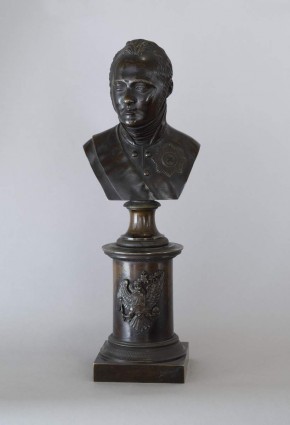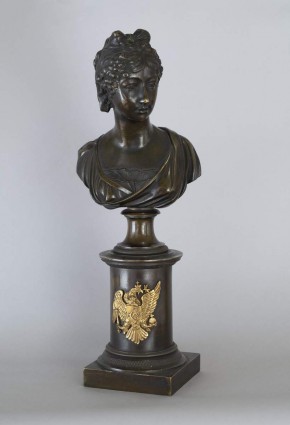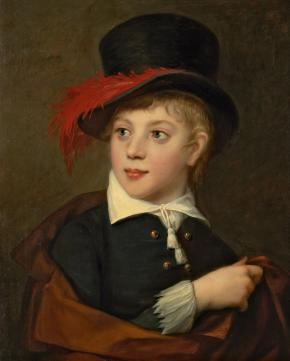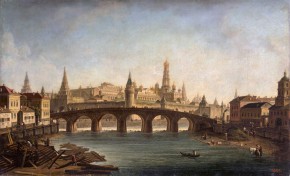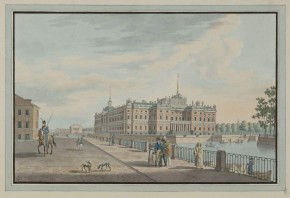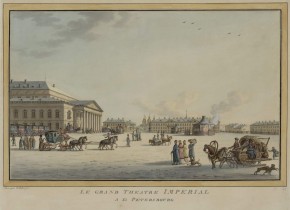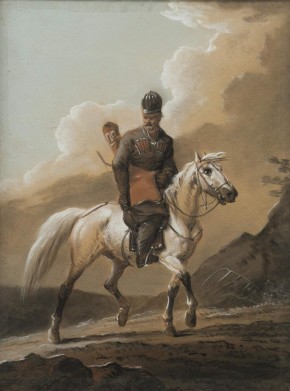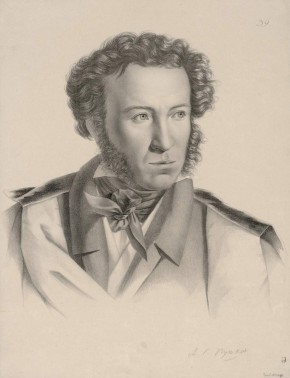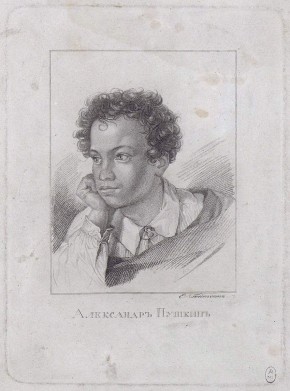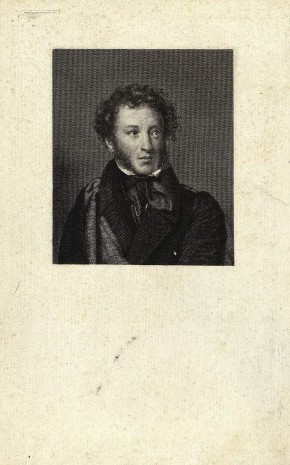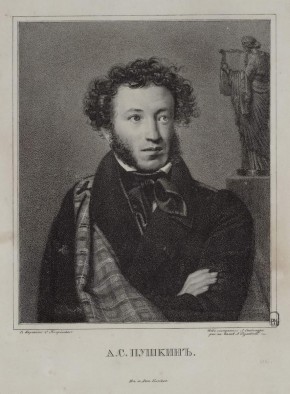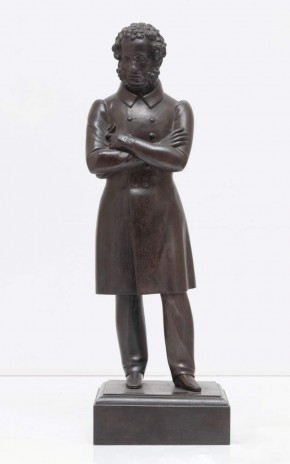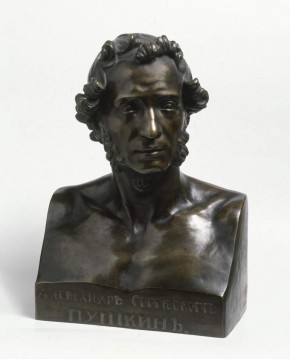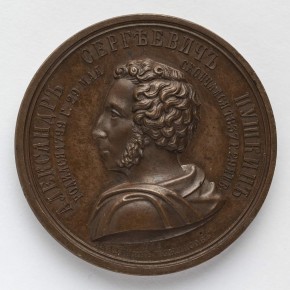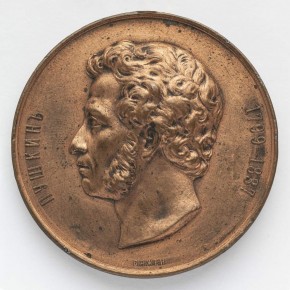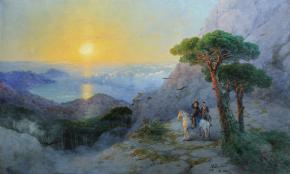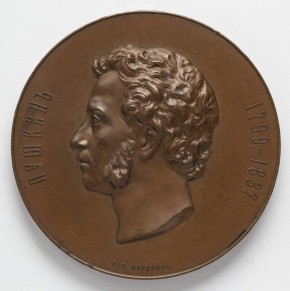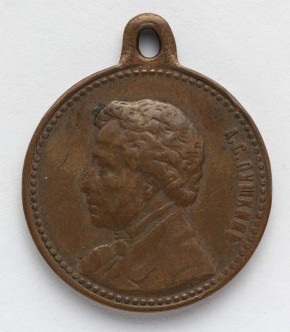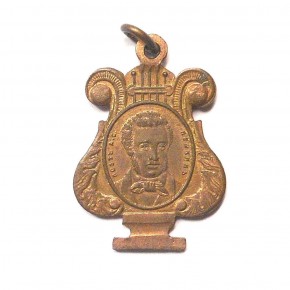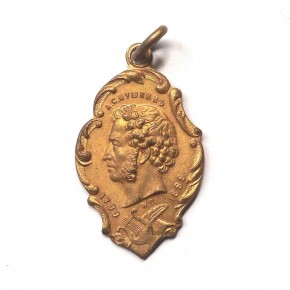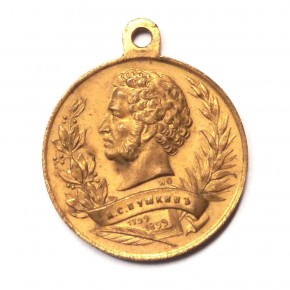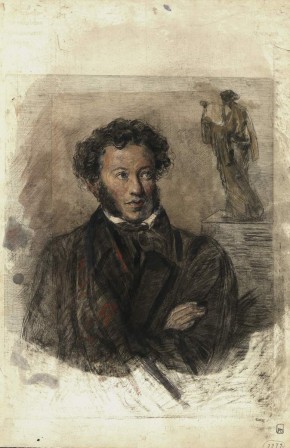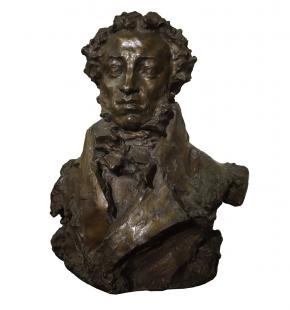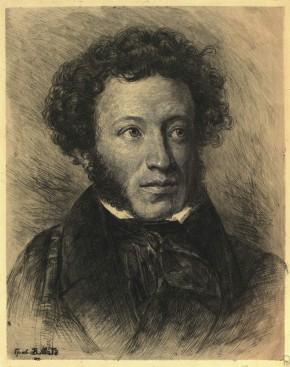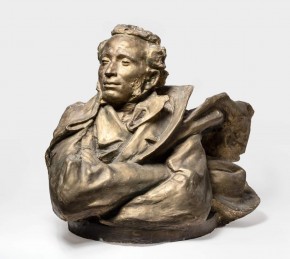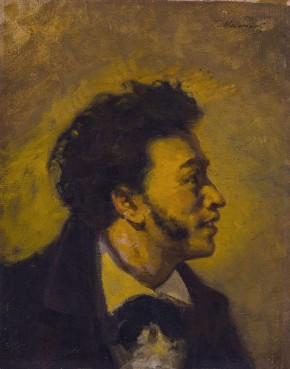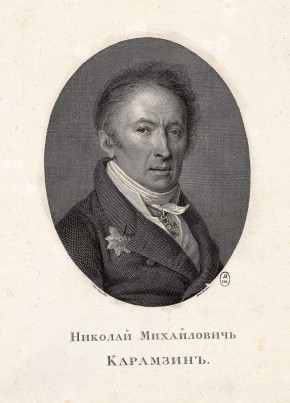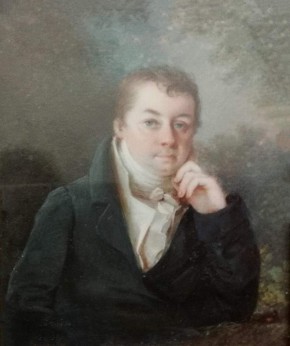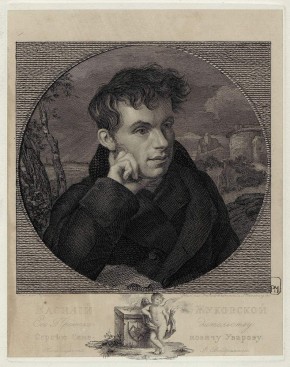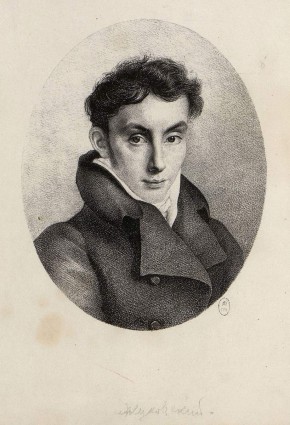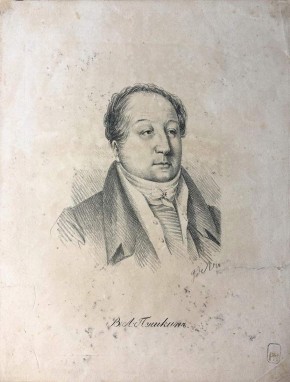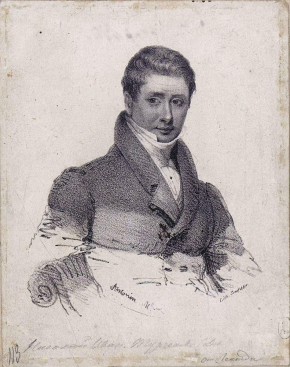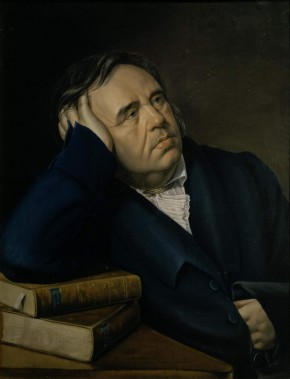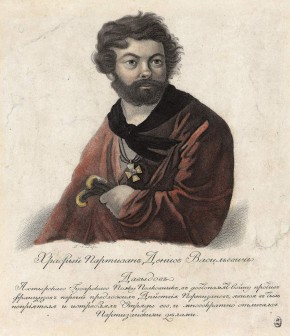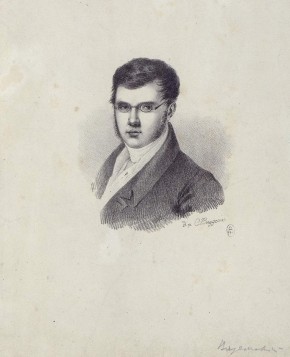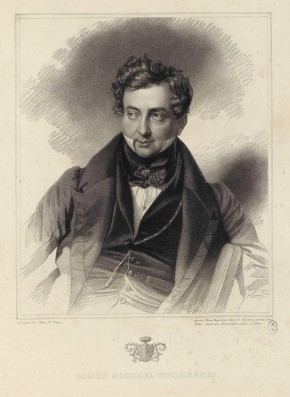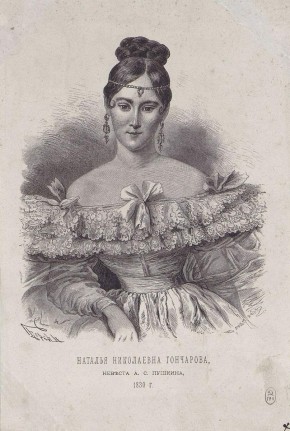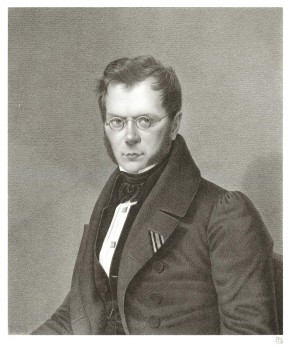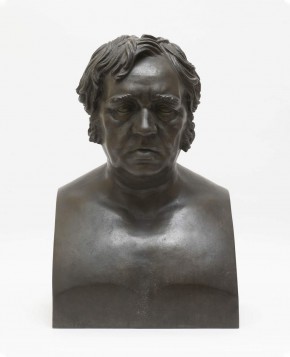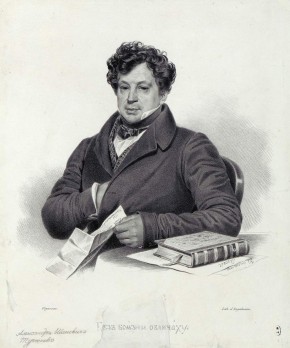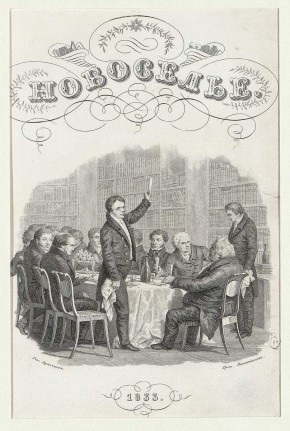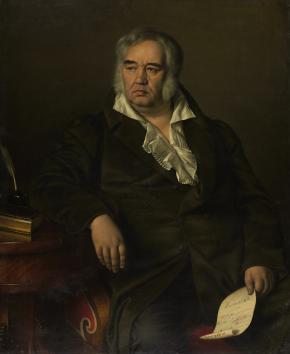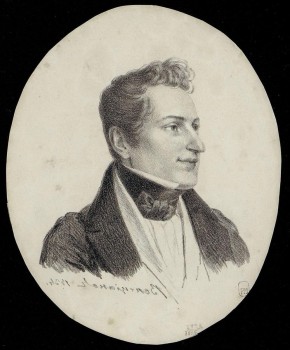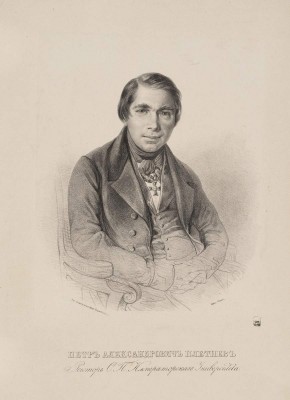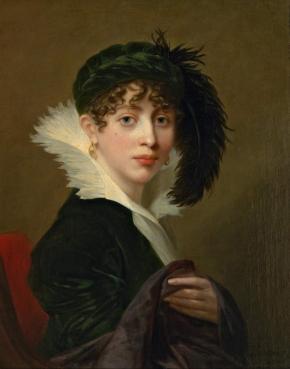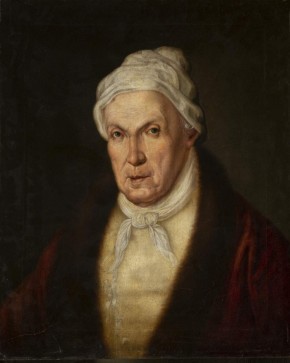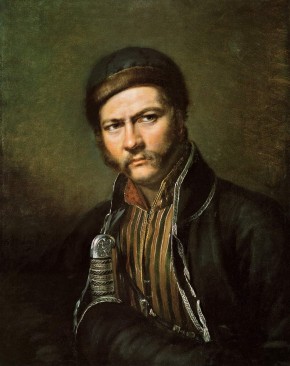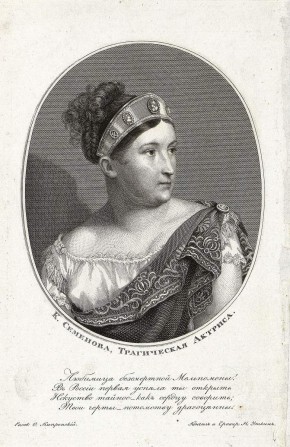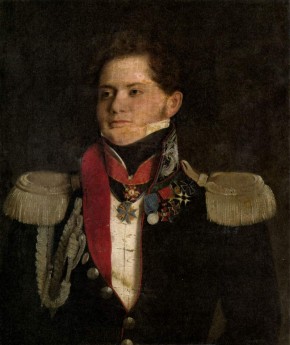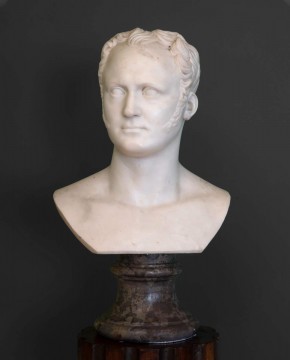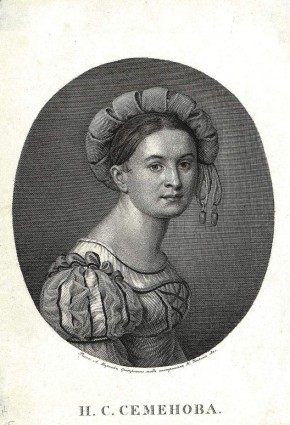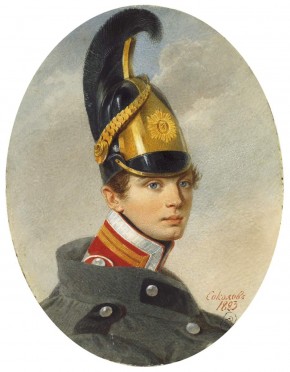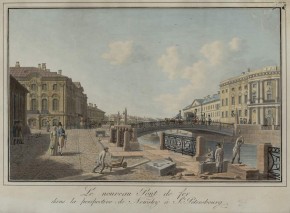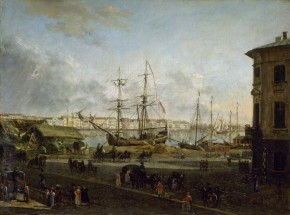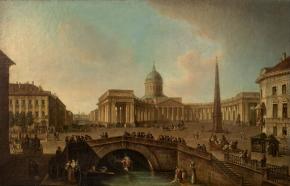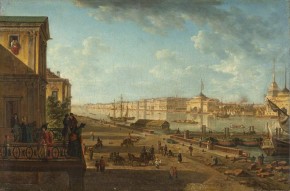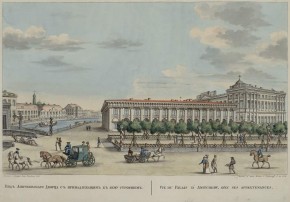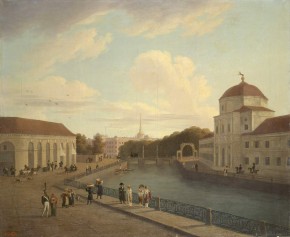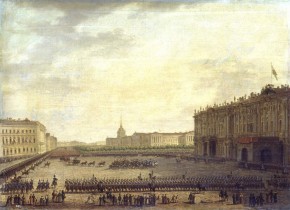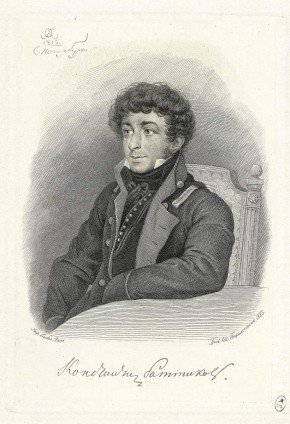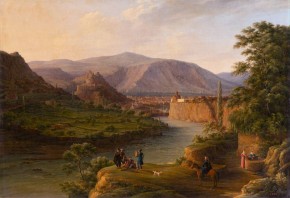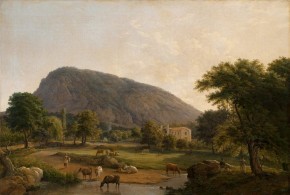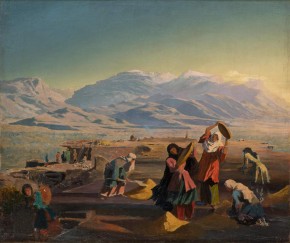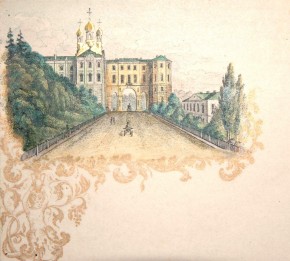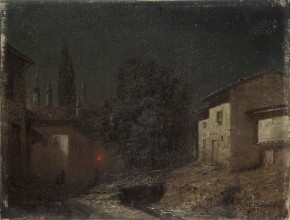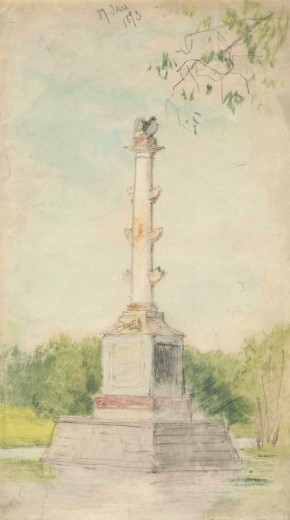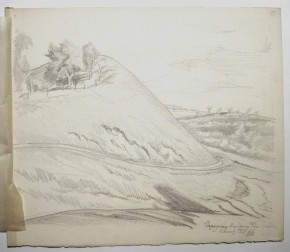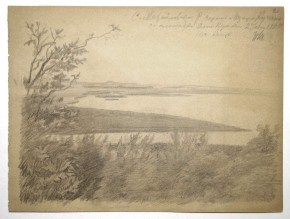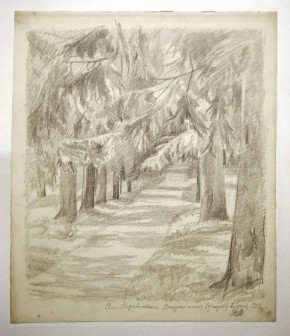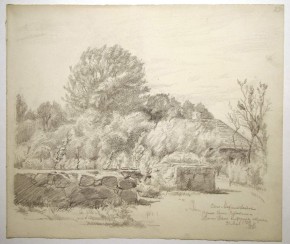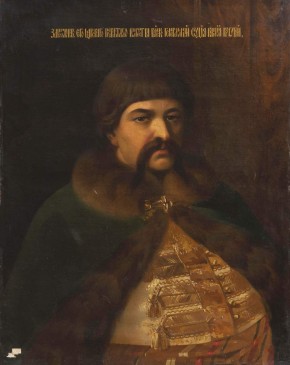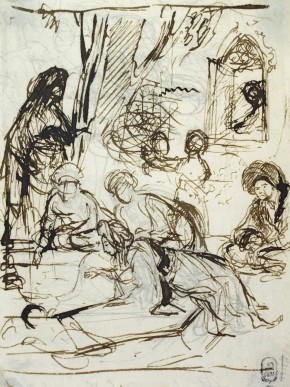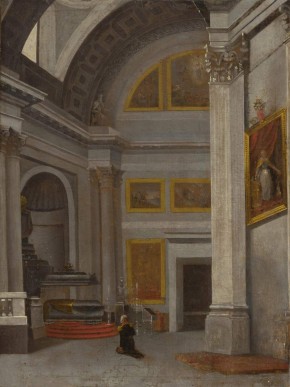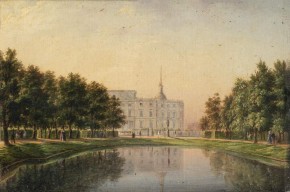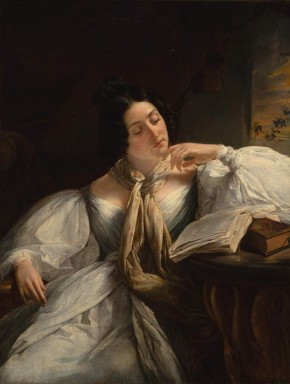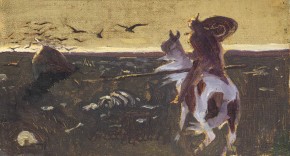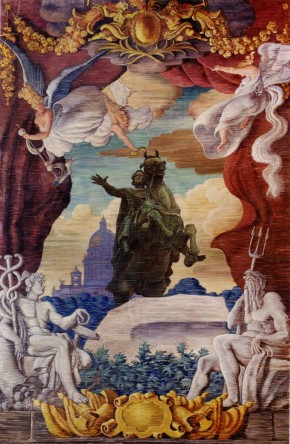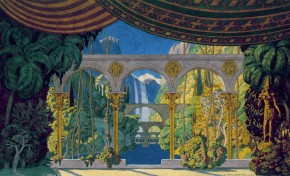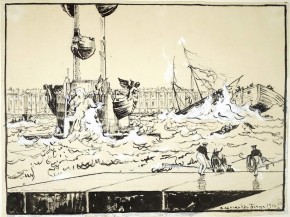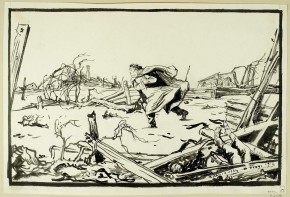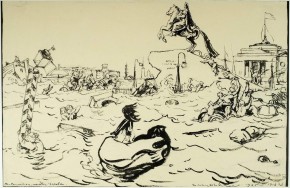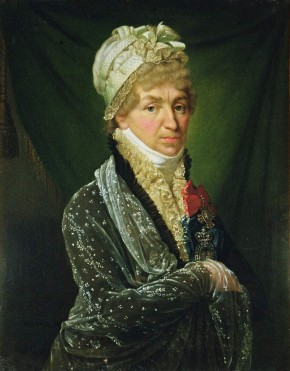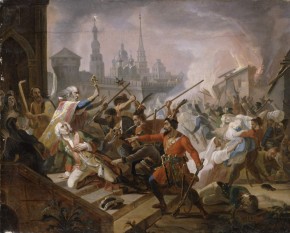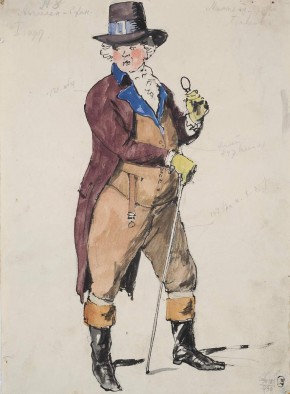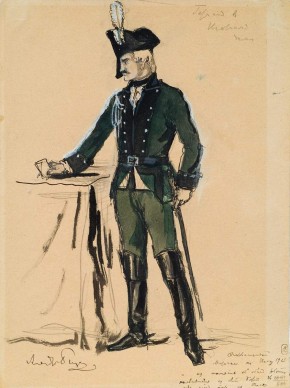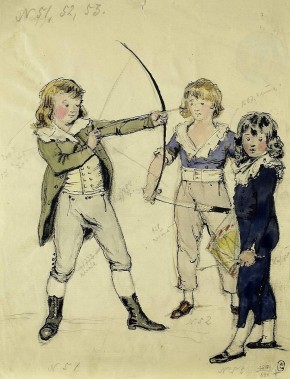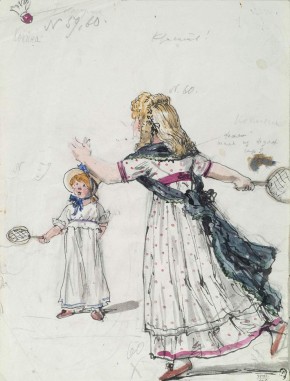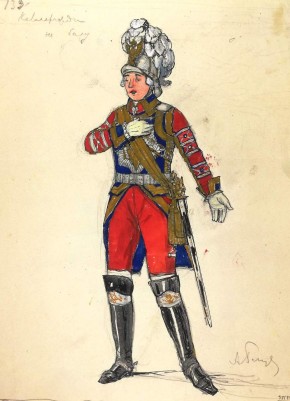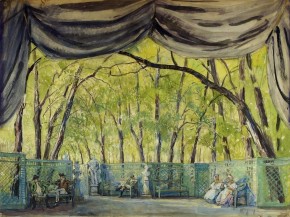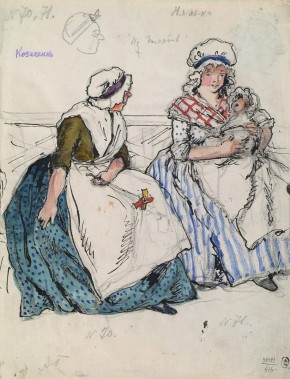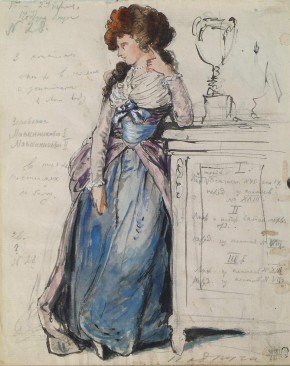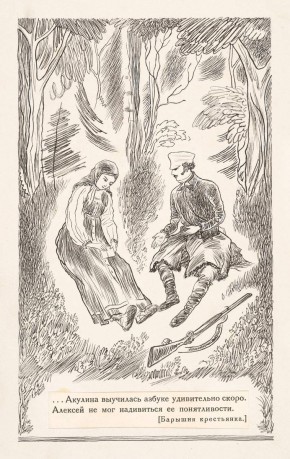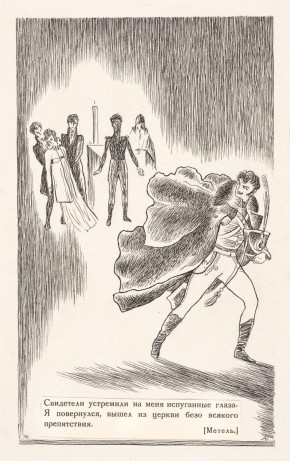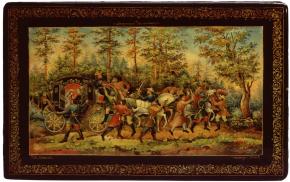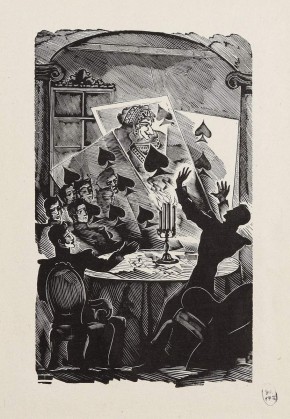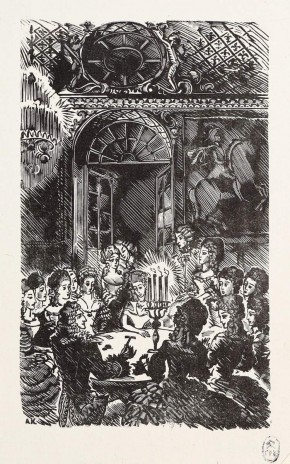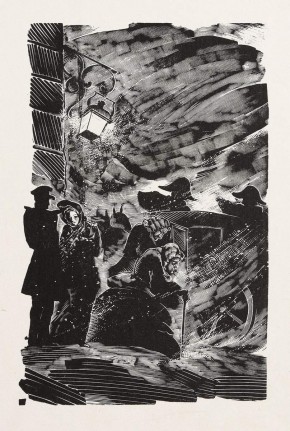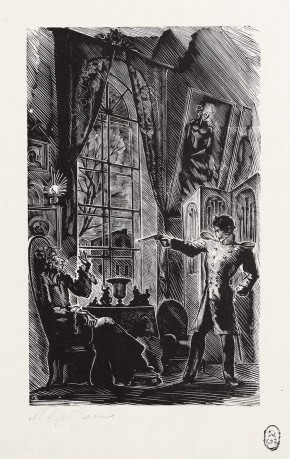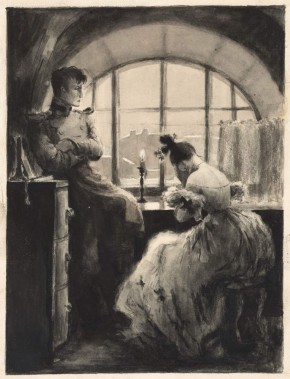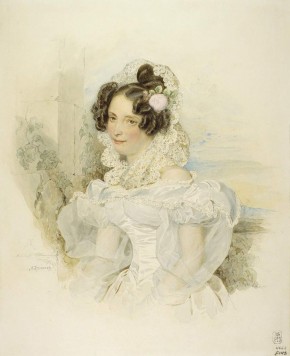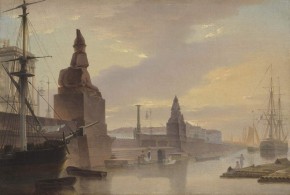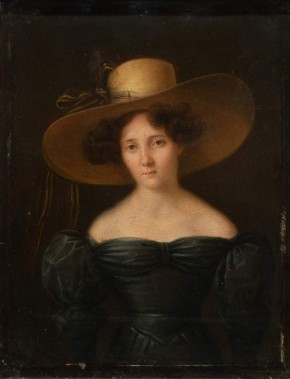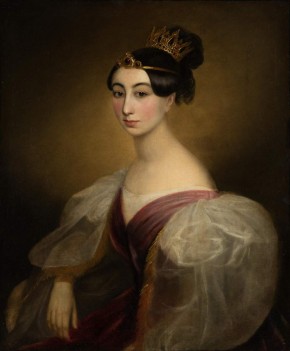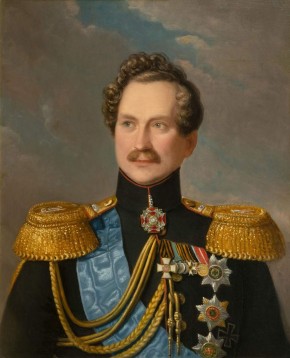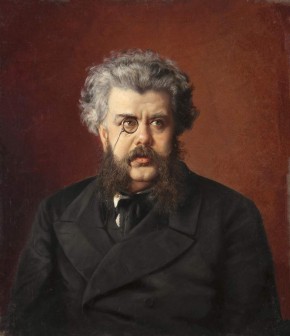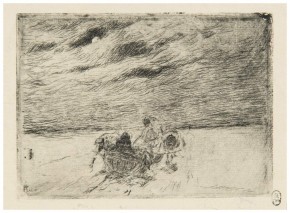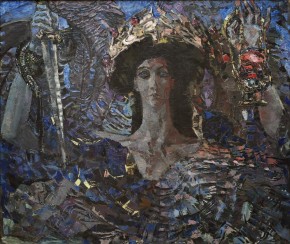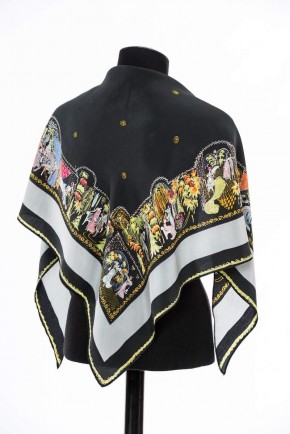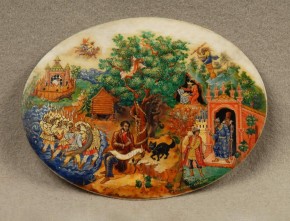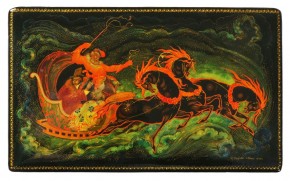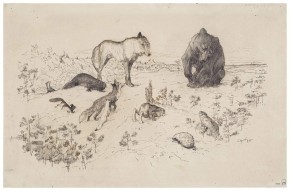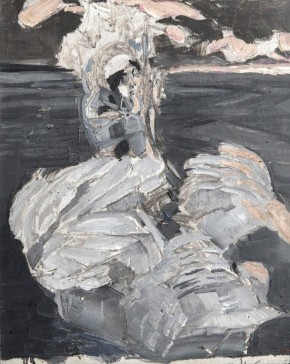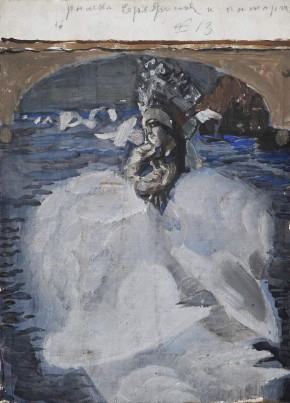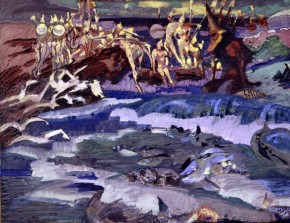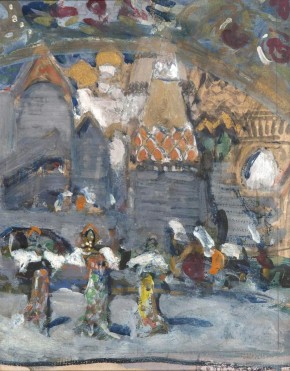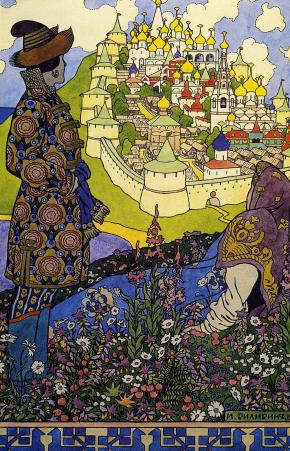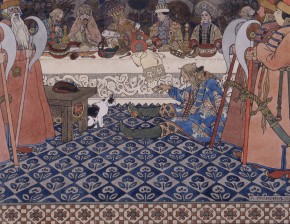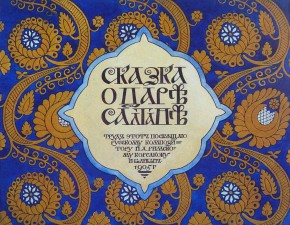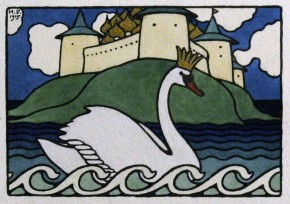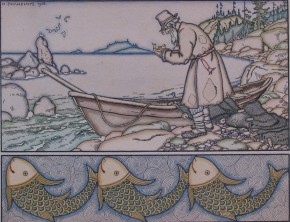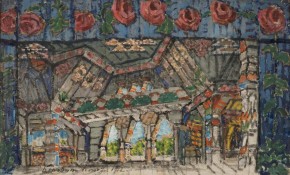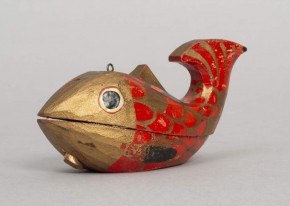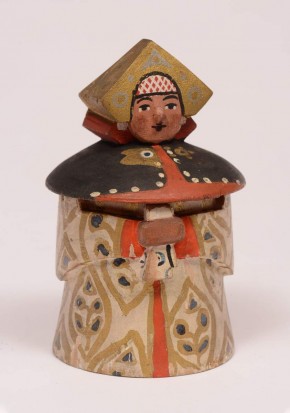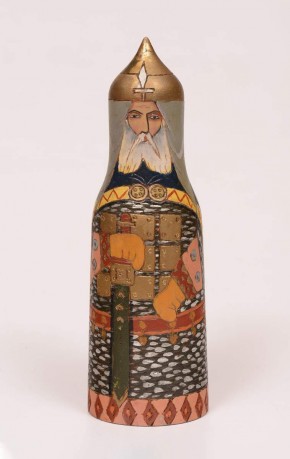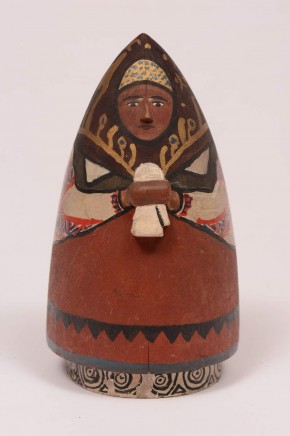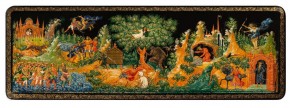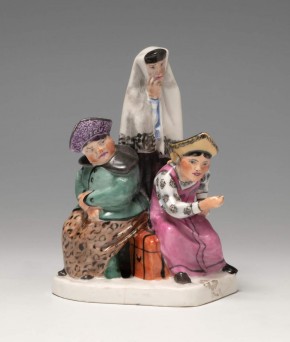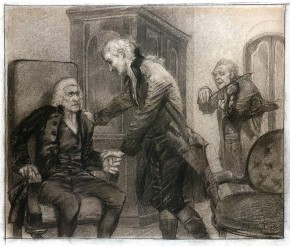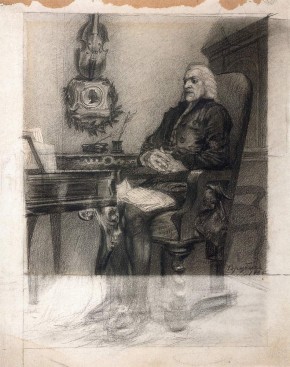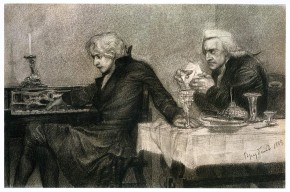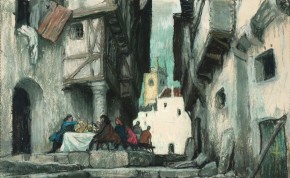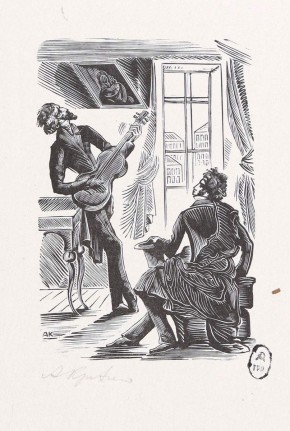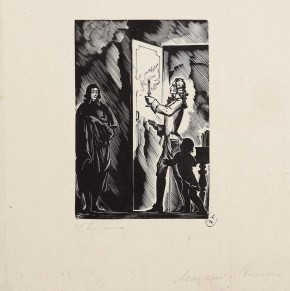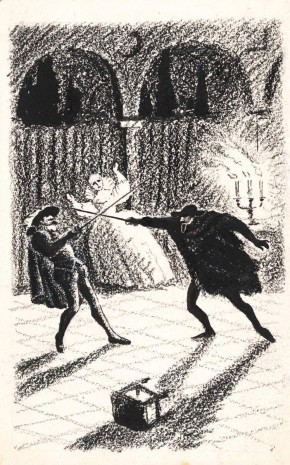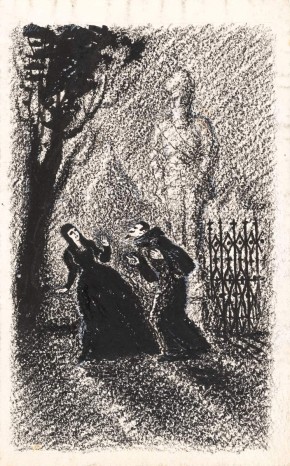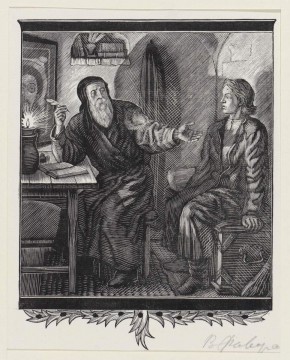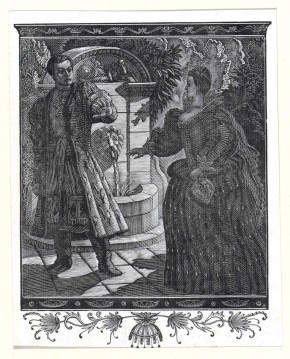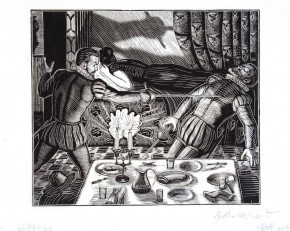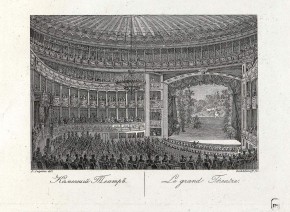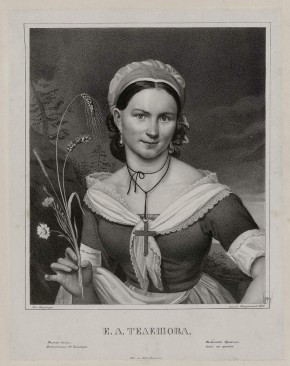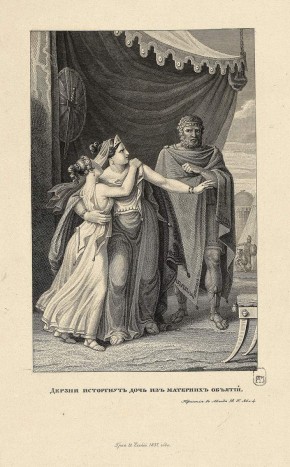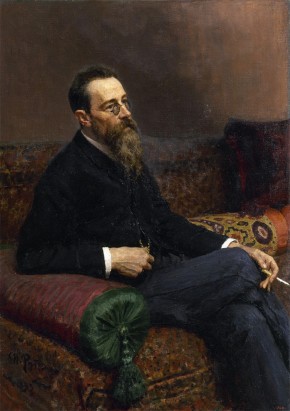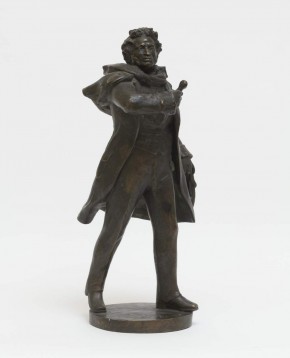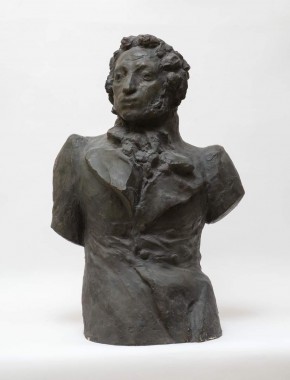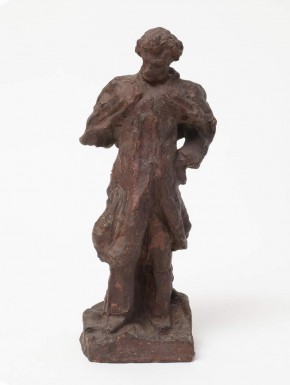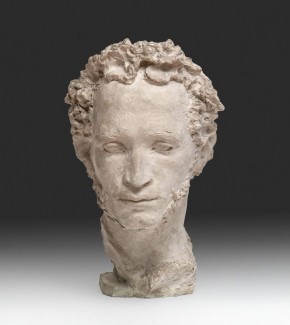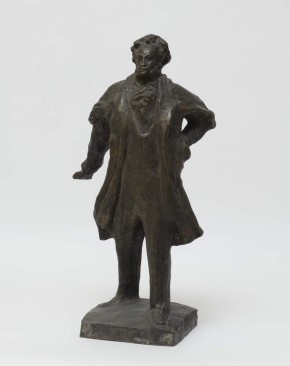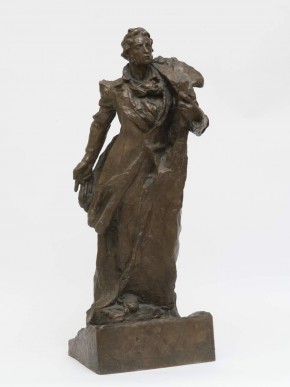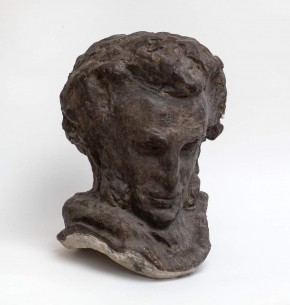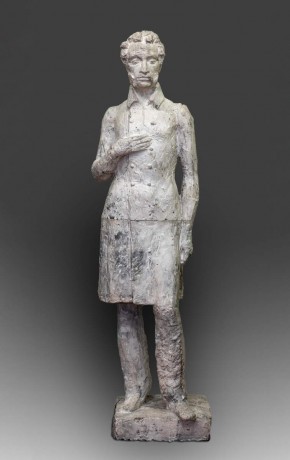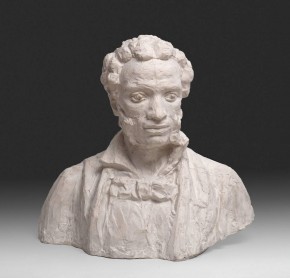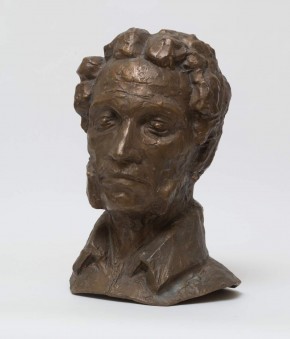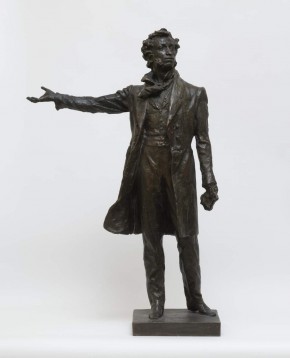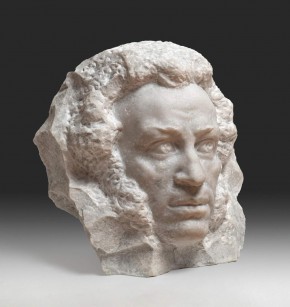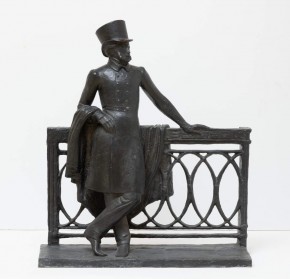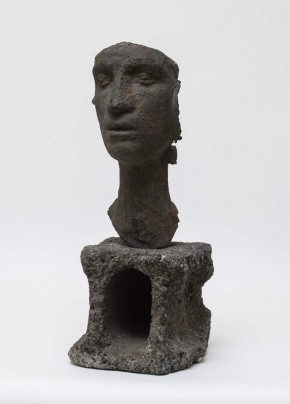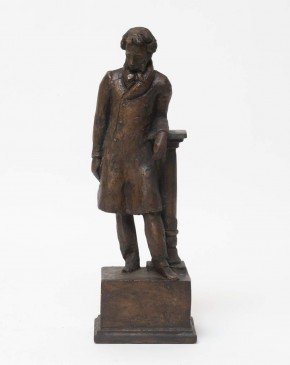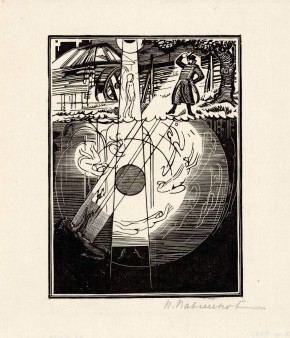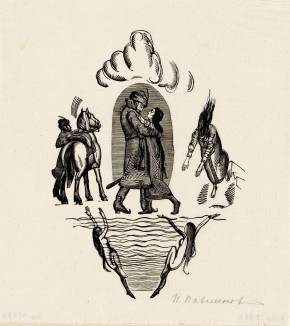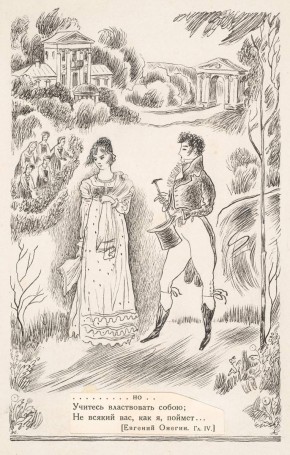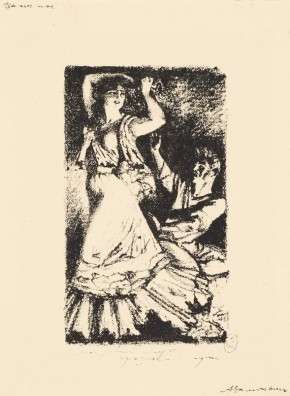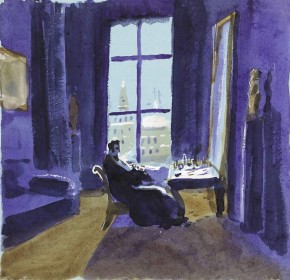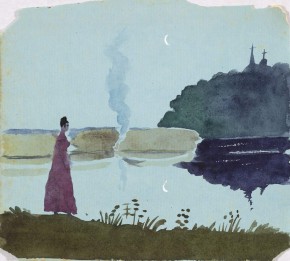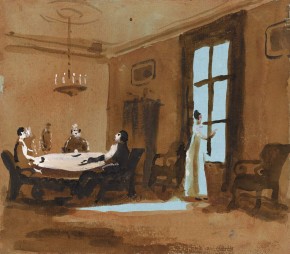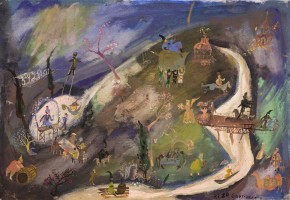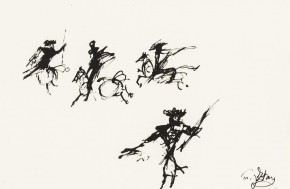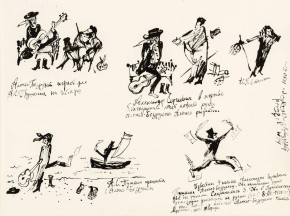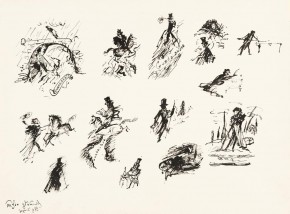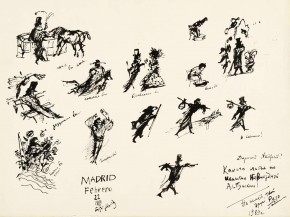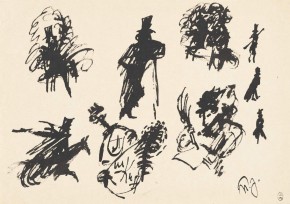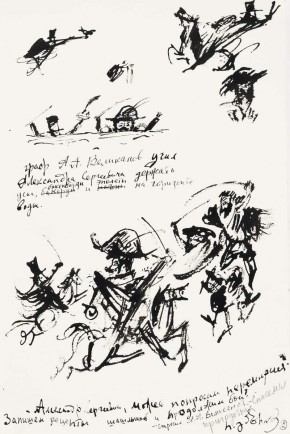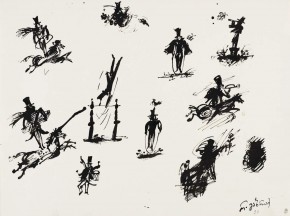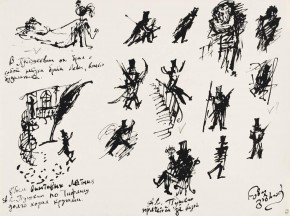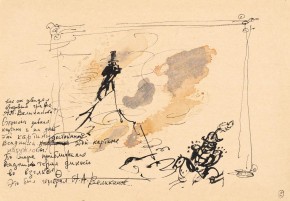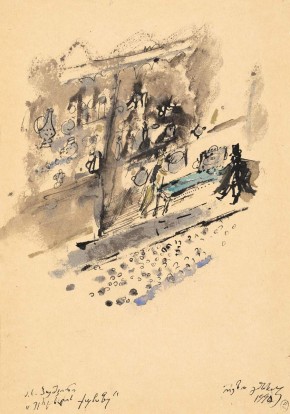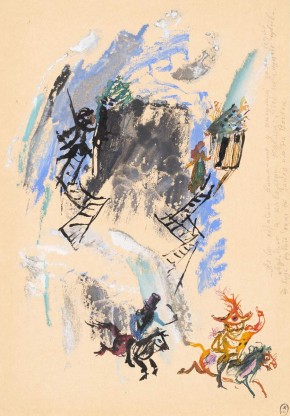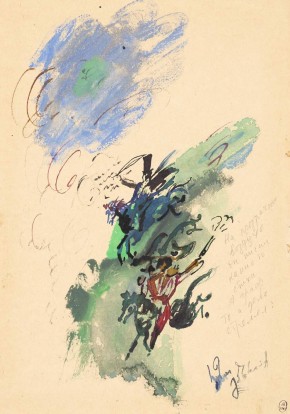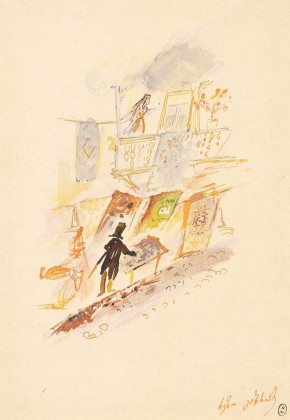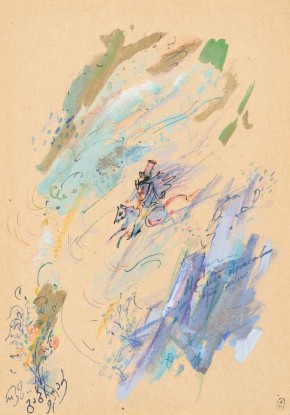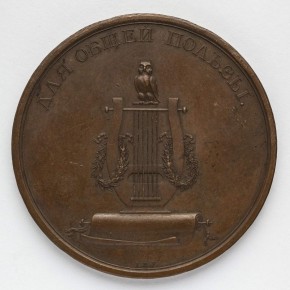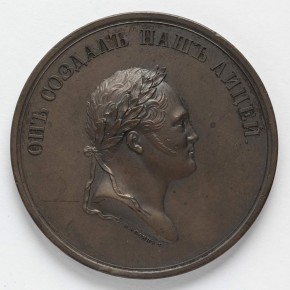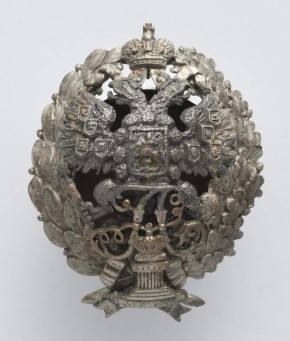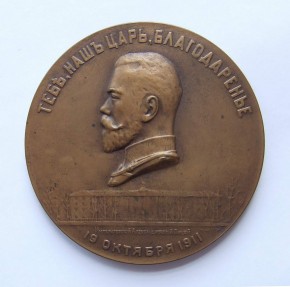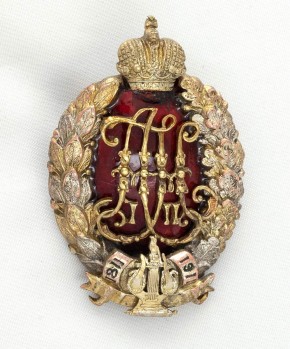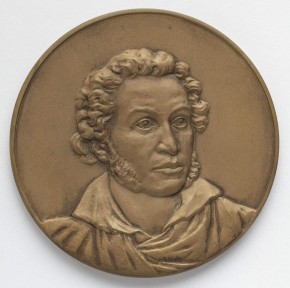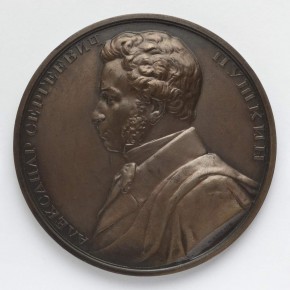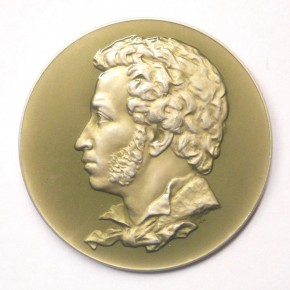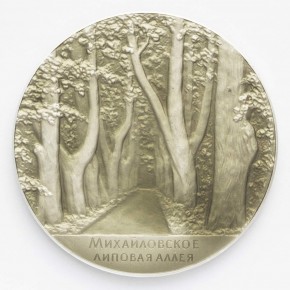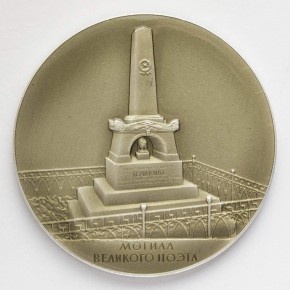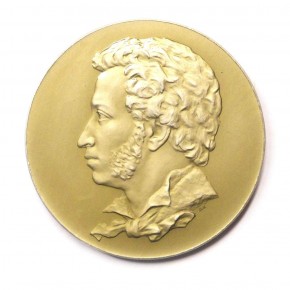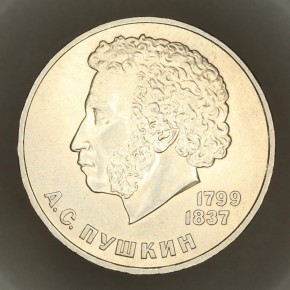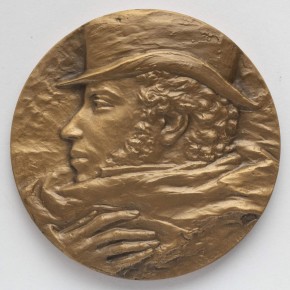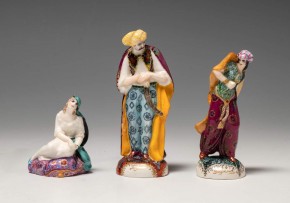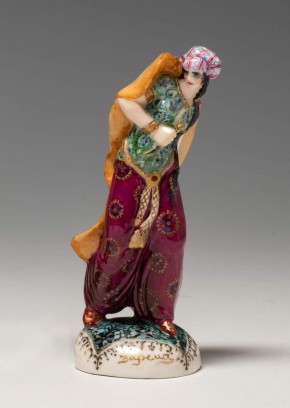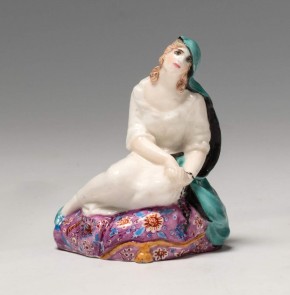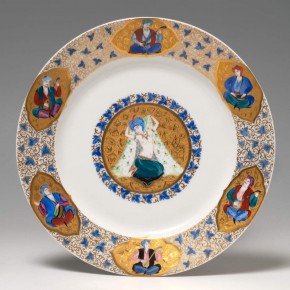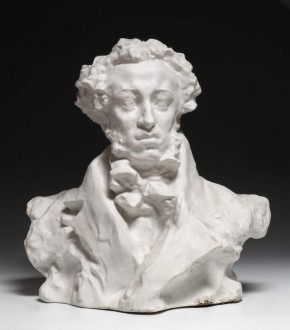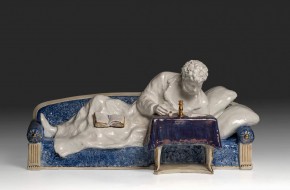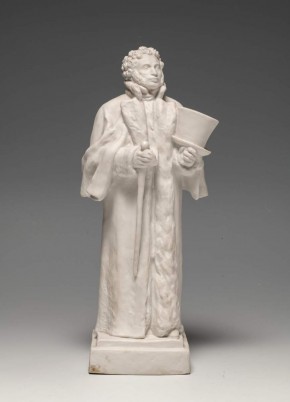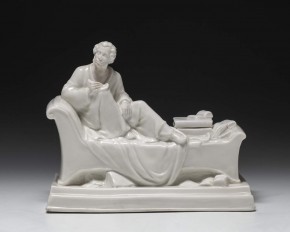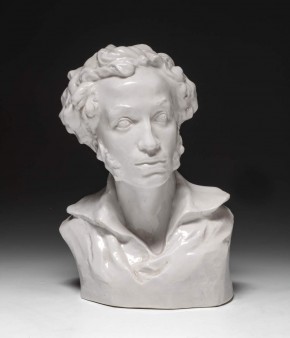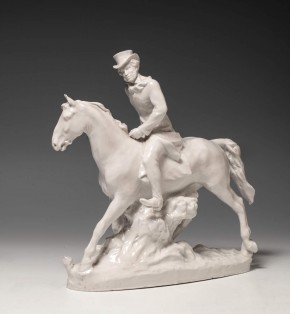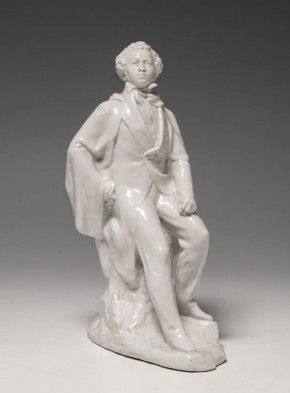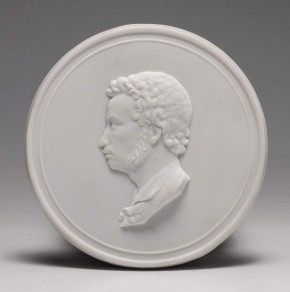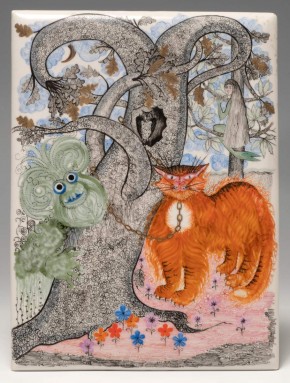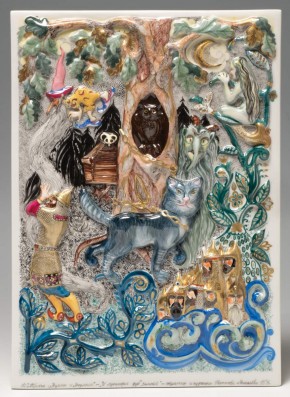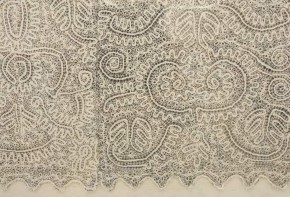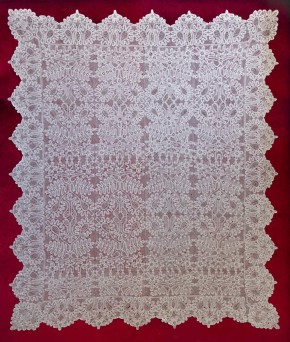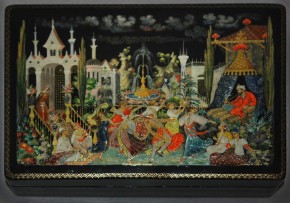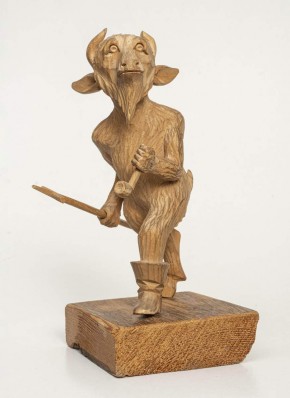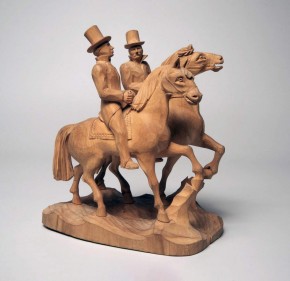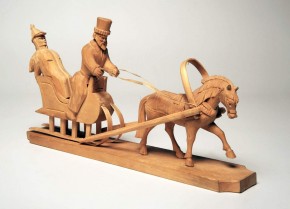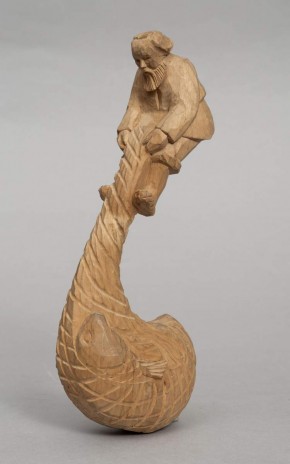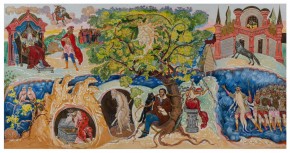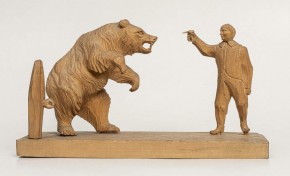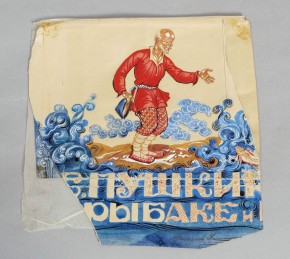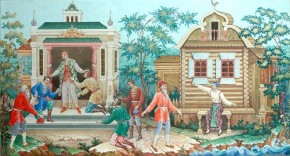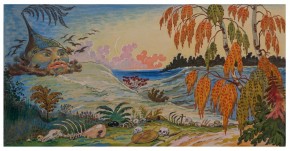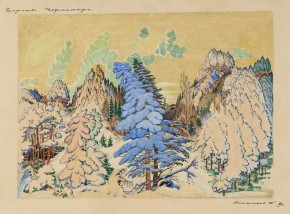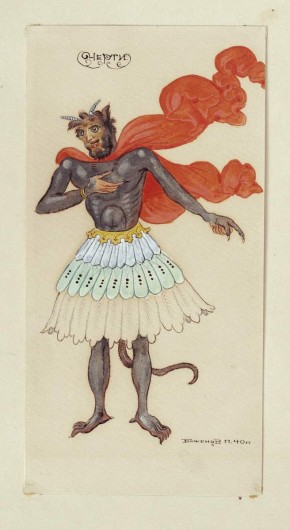Advanced search collections
PUSHKIN, His Time and Heroes in the Collection of the Russian Museum
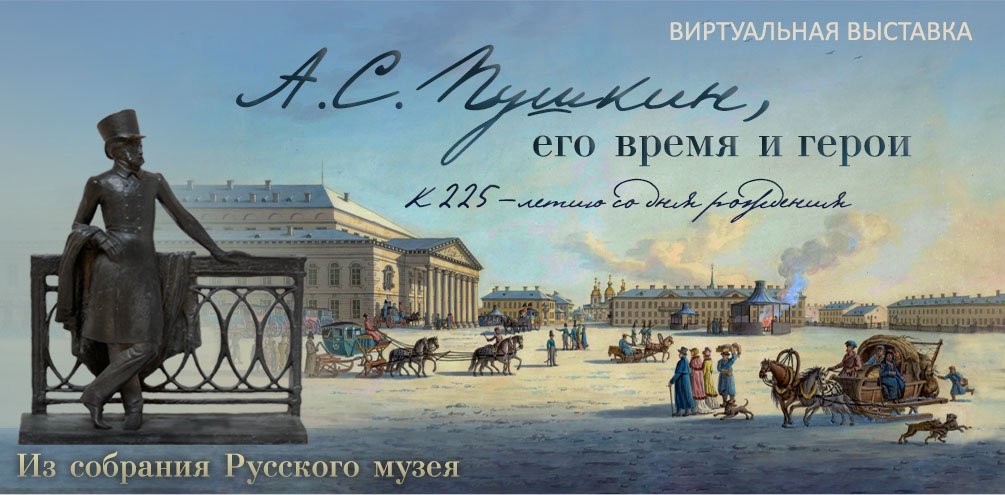
View onto the Moskvoretsk Bridge and the Kremlin
- Canvas, oil.
- The State Russian Museum
- Ж-4679
View onto Moscow from the Balcony of the Kremlin Palace in the Direction of the Moskvoretsky Bridge
- Canvas, oil.
- The State Russian Museum
- Ж-4681
This work depicts the view onto Moscow from the highest point of the Kremlin Hill. The white wall and towers of the ancient citadel are depicted in close-up. The Kremlin cathedrals can be seen on the left. Although the architectural ensemble of the Kremlin was already in place by the 1330s, it was rebuilt on a number of occasions, following fires and wars. The blocks of white stone at the wall on the right show that reconstruction of the Kremlin Hill continued even in the late eighteenth century. The building in the background is the Foundling Hospital, opened by Catherine the Great under the influence of the humanitarian ideas of the Enlightenment.
View of Palace Embankment from the Peter and Paul Fortress
- 1790s
- Canvas, oil. 72 x 107
- The State Russian Museum
- Ж-3292
This is a repeat version of a painting for which Fyodor Alexeyev was elected to the Imperial Academy of Arts – View of Palace Embankment from the Peter and Paul Fortress (1794, Tret. Gal.). On the left is the Peter and Paul Fortress with the Naryshkin Bastion. The Naryshkin Bastion was renamed the Catherine Bastion after the wife of Peter the Great (1725). The Summer Garden can be seen on the opposite bank of the River Neva. Palace Embankment begins on the right with the Marble Palace and the Betskoi and Saltykov houses.
View of the Peter and Paul Fortress and Palace Embankment
- 1799
- Canvas, oil. 71,5 x 109
- The State Russian Museum
- Ж-5048
This is a repeat version of View of the Peter and Paul Fortress and Palace Embankment (1793, Archangelskoe Mus.). Nikolai Lvov’s Neva Gates and the Commander’s Landing Wharf are depicted in the foreground.
On the opposite bank of the River Neva are part of the Old Admiralty, Winter Palace, Old Hermitage and the Hermitage Theatre (from right to left). The bridge across the Winter Canal can be seen between the Old Hermitage and the theatre. Russian Museum: From Icons to the Modern Times. Palace Editions, St Petersburg, 2015. P. 111.
Moscow. View of the Resurrection Gate. (View of the Resurrection Gate of Kitay-Gorod)
- Paper, watercolour.
- The State Russian Museum
- Р-1462
Москва. Вид от Троицких ворот на Кутафью башню и дом Пашкова
- Paper, gouache. 44 x 60,9
- The State Russian Museum
- Р-1459
Площадь в Московском Кремле
- Canvas, oil.
- The State Russian Museum
- Ж-6289
Портрет Д. В. Кочубея мальчиком
- Watercolour.
- The State Russian Museum
- Ж-838
View of Ice Slopes in Moscow during ShroveWeek
- After the original by De la Barthe Gerard Ice Slopes in Moscow on Neglinnaya Street during ShroveWeek
- early 1800s
- Paper, etching, aquatint with hand colouring.
- The State Russian Museum
- Гр.-31615
View of Mokhovaya Street and the Pashkov House in Moscow
- After the original by De la Barthe Gerard View of Mokhovaya Street and the Pashkov House in Moscow
- early 1800s
- Paper, etching, aquatint with hand colouring.
- The State Russian Museum
- Гр.-31605
Вид на Академию художеств и Кадетский корпус
- Canvas, oil.
- The State Russian Museum
- Ж-3155
Портрет императора Александра I (1777–1825)
- 1801–1804
- Bronze. 35 х 12,5 х 11
- The State Russian Museum
- СК-219
Портрет императрицы Елизаветы Алексеевны (1779–1826), жены Александра I
- 1801–1804
- Bronze. 36 х 13 х 9,5
- The State Russian Museum
- СК-223
Portrait of Alexander Stroganov
- Canvas, oil.
- The State Russian Museum
- Ж-4594
Count Alexander Stroganov (1794-1814) was the only son of Sofia and Pavel Stroganovs. He went to the army in the field with his father during the Patriotic War of 1812. He was tragically killed during the Battle of Craonne in France (A shot from a cannon decapitated him).
View of the Moscow Kremlin from the Stone Bridge
- 1800-1810
- Canvas, oil. 63 х 103
- The State Russian Museum
- Ж-3291
In 1800, with funds from the Imperial Cabinet, the artist Fyodor Alexeyev began work on a series of views of Moscow. This painting shows us one of the most entrancing panoramas that travellers would see when visiting the city. The majestic Kremlin, the massive stone bridge and the many old palaces and chambers squeezing in along the embankment were all a reminder of the time of the Kingdom of Muscovy. During Napoleon’s invasion of Russia in 1812 Moscow, which was occupied by the French, suffered an immense fire that caused irreparable damage to the city’s appearance. The picture is thus a historical document that allows us to get a visual impression of the ancient capital of Russia.
Михайловский замок в Санкт-Петербурге
- 1800s
- Paper, .
- The State Russian Museum
- Гр.-34771
Большой императорский театр в Петербурге
- Paper, coloured etching.
- The State Russian Museum
- Гр.-30338
Черкес
- 1807
- Paper, pastel. 52 x 38,5
- The State Russian Museum
- Ж-3398
Portrait of Count Pavel Stroganov
- 1808
- Canvas, oil. 69 х 56,5
- The State Russian Museum
- Ж-4596
Pavel Stroganov (1772–1817) was count and son of Alexander Stroganov and Yekaterina Petrovna (née Trubetskaya). He traveled a great deal around Russia. He went to Switzerland in order to complete his education and went to Paris in 1789. He took part in events of the French Revolution. He was called back to Russia in 1790. He became a gentleman in waiting in 1798. He was a member of the Private Committee at the beginning of the reign of Alexander I. He was also the assistant of the Minister of the Internal Affairs. He became a senator in 1806. He fought in the Finnish War (1808-1809), the Russo-Turkish War (1806-1812) and the Patriotic War of 1812.
Portrait of Count Yevgraf Komarovsky
- Canvas, oil.
- The State Russian Museum
- Ж-4588
Yevgraf Fedotovich Komarovsky (1769–1843) was a Count, adjutant general, and a general of the Infantry. He was the son of a small court official. He was an ensign in the Izmailovsky Life Guards Regiment (1792). He was adjutant to the Grand Duke Konstantin Pavlovich, with whom he participated in the Italian and Swiss campaigns led by Alexander Suvorov. He was major general (1799), adjutant general (1801), Count of the Holy Roman Empire (1803). He acted as assistant to the St Petersburg military governor (1802), inspector of the Internal Guard (1811), temporary military governor of St Petersburg (1824). In 1828 he was made general of the Infantry and named senator. He left “Notes” (St Petersburg 1914). He appears here in standard general’s uniform, with the monogram of Emperor Alexander I on the epaulettes. Orders: St Vladimir of the 2nd class (5 October 1813, cross on the neck and star; the emblems of the order were approved later), St Anne of the 1st class (16 March 1806, ribbon), Commander’s cross of the Order of St John of Jerusalem (Maltese cross, 29 October 1799), Sardinian cross of St Lazarus and Mauritius of the 3rd class (received before 1802).
De La Barthe G.
Circa 1730 - ?French painter, landscapist. Studied under Joseph-Marie Vien. Worked in Russia (1787–1810). Information on the artist is extremely sketchy. Several publications identify him with his namesake, also a painter who worked in the latter half of the eighteenth century. Painted a series of views of Moscow and its environs in oil and watercolours (1794‒1798) which are well-known thanks to the engravings done by various engravers, first published in Moscow in 1799 by Johann Walser.
Alexeyev Fyodor Yakovlevich
1753/1754 (?). St Petersburg - 1824, St PetersburgPainter, founding father of the Russian school of urbanscape painting. Son of a guard at the Imperial Academy of Arts. Studied fruit and flower and landscape painting at the Imperial Academy of Arts (1766-73). Awarded a fellowship to Venice (1773-77). Studied under Giuseppe Moretti and Pietro Gaspari. Returned to St Petersburg and worked as a painter for the Imperial Theatres (1799). Copied paintings by Canaletto and Bernardo Bellotto for Catherine the Great. Nominated to the Academy (1794). Sketched places visited by Catherine the Great (1787) in south Russia (1795). Painted urbanscapes in Moscow (1800). Councillor of the Imperial Academy of Arts (1802), Taught perspective painting at the Imperial Academy of Arts (1803-24).
Moshkov Illarion Vasilyevich
Unknown painter
Lory Gabriel Ludwig, circle of
Lory Gabriel Ludwig
Mayr (de Mayr, von Mayr, Mayer, Meyer) Johann Georg
1760, Nuremberg (Germany) - 1816, St PetersburgPainter, draughtsman, landscapist, portraitist, il¬lustrator, engraver. Elder brother of the draughts-man and engraver Johann Christoph Mayr. Studied in Nuremberg. Invited to St Petersburg (1778). Worked atthe Imperial Academyof Sciences, draw¬ing inventions and texts , turning sketches into finished drawings for copper engraving, correct¬ing new engravings and teaching drawing, engrav¬ing and watercolour painting. Awarded more du¬ties and students following the appointment of Princess Ekaterina Dashkova as director of the Im¬perial Academy of Sciences (1783). Painted en¬gravings made by other artists (from 1788).
Unknown sculptor
Mosnier Jean Laurent
1743 (4?), Paris — 1808, St PetersburgFrench painter, portraitist, miniaturist. Pupil of Louis-Jean-François Lagrenée the Elder. Court painter to Queen Marie Antoinette and Louis XVI. Contributed to the Paris Salon. Admitted into the Paris Academy of Arts in 1788. Fled to London during the French Revolution. Worked in Russia (1795(6?)–1808). Moved to St Petersburg (1795(6?)). Academician of the Imperial Academy of Arts (1802), headed the portrait class (from 1806).
Патерсен Беньямин
Orlovsky, Alexander Osipovich
1777, Warsaw å 1832, St PetersburgDraughtsman, lithographer, painter, genre artist, portraitist, landscapist, battle-painter, animalist. Studied in Jean Pierre Norblin de la Gourdaine s studio in Warsaw. Lived in St Petersburg (from 1802) where he was in the staff of Grand Duke Konstantin Pavlovich. Academician for Cossack Bivouac (1809). Created Horsemen (1816), the first dated lithograph in Russia. At the end of the 1810s through the 1820s, he created several series of
lithographs of scenes from Russian folk life that were very successful. A rare example of the artist s work in book graphic art is his illustrations to the fables of Ivan Krylov (1824). Intended for publica¬tion in 1825, they were printed by the Circle of Lovers of Fine Publications only in 1907.
Портрет А. С. Пушкина
- 1822
- Paper, lithography.
- The State Russian Museum
- Гр.-7655
Портрет А. С. Пушкина в юности
- 1822
- Paper, .
- The State Russian Museum
- Гр.-21505
Портрет А. С. Пушкина
- 1827
- Paper, .
- The State Russian Museum
- Гр.-20754
А. С. Пушкин
- 1829–1830
- Paper, lithography.
- The State Russian Museum
- Гр.-36395
Титульный лист к альманаху «Новоселье»
- 1834
- Paper, etching, .
- The State Russian Museum
- Гр.-20755
А. С. Пушкин
- 1837
- . 46 х 16 х 15
- The State Russian Museum
- Ск-383
Портрет А. С. Пушкина
- 1837
- Bust., bronze. 52 х 37 х 22
- The State Russian Museum
- СК-2077
На 25-летие со дня смерти А. С. Пушкина
- Bronze.
- The State Russian Museum
- Мед.А-1984
Медаль для рецензентов сочинений на соискание премии А. С. Пушкина от Императорской Академии наук
- 1881–1885
- Bronze.
- The State Russian Museum
- Мед.А-1885
Alexander Pushkin at the Top of Ai-Petri at Sunrise
- 1899
- Canvas, oil. 135 х 250
- The State Russian Museum
- Ж-11746
В память 100-летия со дня рождения А. С. Пушкина
- Bronze.
- The State Russian Museum
- Мед.А-2049
Жетон на 100-летие со дня рождения А. С. Пушкина
- Bronze.
- The State Russian Museum
- Мед.А-4509
Жетон на 100-летие со дня рождения А. С. Пушкина
- Bronze.
- The State Russian Museum
- Мед.А-2592
Жетон на 100-летие со дня рождения А. С. Пушкина
- 1899
- Bronze.
- The State Russian Museum
- Мед.А-2588
Жетон на 100-летие со дня рождения А. С. Пушкина
- Bronze.
- The State Russian Museum
- Мед.А-2590
Портрет А. С. Пушкина
- 1899 (?)
- Paper, .
- The State Russian Museum
- Гр.-19461
Портрет А. С. Пушкина
- Bronze.
- The State Russian Museum
- Ск-1762
Портрет А. С. Пушкина
- 1899
- Paper, etching.
- The State Russian Museum
- Гр.-19460
Проект памятника А. С. Пушкину
- 1902
- . 72 х 76 х 63
- The State Russian Museum
- Ск-1060
Голова А. С. Пушкина
- 1906–1907
- Canvas mounted on cardboard, oil. 33 x 26
- The State Russian Museum
- Ж-2514
Гейтман Егор Иванович
Гиппиус Густав Фомич (Густав Адольф)
Уткин Николай Иванович
Безлюдный Андрей Семенович
Галактионов Степан Филиппович
Vitali Ivan Petrovich
1794, St.Petersburg – 1855, St.PetersburgSculptor. Studied at the Agostino Triscorni’s studio in St Petersburg (1816–1818), and simultaneously at the Imperial Academy of Arts as an occasional student. Worked in Moscow (1818–1841). Created decorative compositions for the Board of Guardianship’s building (1823–1825), statues and reliefs for the Triumphal Arch in Moscow erected to commemorate Russia’s victory over Napoleon (1829–1834, together with I. Timofeyev). Author of fountains on Theatre and Lubyanka Squares (1835). Moved from Moscow to St Petersburg (1841). Professor of the Imperial Academy of Arts (1842). Headed the sculptural workshop during the construction of St Isaac’s Cathedral (1841–1854). Produced a number of portraits and gravestones in Moscow and St Petersburg.
Теребенев Александр Иванович
Чукмасов Иван Иоакимович
Aivazovsky (Haivazovsky) Ivan (Hovhannes) Konstantinovich
1817, Theodosia - 1900, ibidemTheodosia Painter, graphic artist. Studied at the Imperial Academy of Arts (1833-1838). Fellow of the Imperial Academy of Arts in the Crimea and Italy (1838-1844). Academician (1844), professor (1847), honorary member of the Imperial Academy of Arts (1887). Member of the Accademia di San Luca in Rome (1840) and the academies of Paris (1843), Amsterdam (1845), Florence (1875) and Stuttgart (1879). Contributed to around 120 exhibitions (from 1835). Contributed to the exhibitions of the Imperial Academy of Arts (1835-1900), Paris Salon (1843, 1879), Society of Exhibitions of Works of An (1876-1883), Moscow Society of Lovers of the Arts (1881), Pan-Russian Exhibitions in Moscow (1882) and Nizhny Novgorod (1896), International Exhibitions in Philadelphia (1876), Munich (1879) and Berlin (1886) and the World Exhibitions in Paris (1858, 1878), London (1863) and Chicago (1893). Awarded the Legion d\'honneur (1857). Lived and worked in Theodosia, where he founded the General Art Studios (1865) and the Theodosia Picture Gallery (1880).
Grilikhes Abram
Матэ Василий Васильевич
Unknown Artist
Островский Владислав
Скуднов Михаил Афанасьевич
Troubetzkoy Paolo (Pavel Petrovich)
1866, Intra, Italy — 1938, Villa Cabianca near Pallanza, ItalySherwood Leonid Vladimirovich
1871, Moscow — 1954, LeningradSmall-scale and monumental sculptor, teacher. Studied at the Moscow School of Painting, Sculpture and Architecture (1886–1892) and the Imperial Academy of Arts (1892–1898) in Petrograd. Contributed to exhibitions (from 1902). Founding member of the New Society of Artists (1904). Honoured Artist of the RSFSR (1946). Doctor of Art Studies (1942).
Miasoedov Grigori
Николай Михайлович Карамзин
- 1818–1819
- Paper, .
- The State Russian Museum
- Гр.-28284
Портрет В. А. Жуковского
- gouache. 9,1 x 8,1
- The State Russian Museum
- Ж-288
Портрет В. А. Жуковского
- 1818
- Paper, .
- The State Russian Museum
- Гр.-25276
Портрет В. А. Жуковского
- 1820
- Paper, lithography.
- The State Russian Museum
- Гр.-32864
Портрет В. Л. Пушкина
- Paper, lithography.
- The State Russian Museum
- Гр.-32964
Портрет Н. И. Тургенева
- Paper, lithography.
- The State Russian Museum
- Гр.-20850
Н. И. Греч
- 1824
- Paper, lithography.
- The State Russian Museum
- Гр.-28672
Портрет баснописца И. А. Крылова
- 1824
- Paper, pastel. 70 х 53,5
- The State Russian Museum
- Ж-3694
Портрет Дениса Давыдова
- 1820s
- Paper, .
- The State Russian Museum
- Гр.-20953
Портрет П. А.Вяземского
- 1820s
- Paper, lithography.
- The State Russian Museum
- Гр.-24695
Граф М. Ю. Виельгоргский
- Paper, .
- The State Russian Museum
- Гр.-27493
Наталья Николаевна Гончарова, невеста А. С. Пушкина
- Paper, woodcut.
- The State Russian Museum
- Гр.-22729
Портрет П. А. Вяземского
- Lithography.
- The State Russian Museum
- Гр.-28642
Портрет писателя И. А. Крылова (1768/69–1844)
- 1830
- Bust., bronze. 59 х 37 х 29
- The State Russian Museum
- СК-365
Портрет А. И. Тургенева
- 1833
- Paper, lithography.
- The State Russian Museum
- Гр.-25357
Титульный лист к альманаху «Новоселье» (Ч.1. СПб, 1833) с виньеткой «Обед у книгоиздателя А. Ф. Смирдина»
- 1833
- .
- The State Russian Museum
- Гр.-21414
Портрет Ивана Андреевича Крылова (1768—1844)
- Canvas, paper.
- The State Russian Museum
- Ж-5250
Портрет Николая Васильевича Гоголя
- 1834
- Lithography.
- The State Russian Museum
- Гр.-25288
Петр Александрович Плетнев ректор Санкт-Петербургского императорского Университета
- 1840s (?)
- Paper, lithography.
- The State Russian Museum
- Гр.-29034
Портрет Н. В. Гоголя
- Canvas, oil.
- The State Russian Museum
- Ж-3476
Borovikovsky Vladimir Lukich
1757, Mirgorod - 1825, St PetersburgPainter, draughtsman, miniaturist, icon painter, portraitist. Born into a family of low rank Cossacks. Studied painting under his father, the icon painter Luke Borovik, in Mirgorod. Listed "above the specified number" in the Mirgorod regiment where his father and relatives served (1774). Awarded the rank of "comrade of the colours" (1783), resigned with the rank of lieutenant. Moved to St Petersburg (1788) and studied under Dmitry Levitsky and Johann Baptiste I Lampi. Nominated to the Imperial Academy of Arts (1794), academician of portrait painting (1795). Councillor of the Imperial Academy of Arts (1802). Contributed to the iconostasis of the Kazan Cathedralin St Petersburg (1804). Mason and member of Ekaterina Tatarinova\'\'s mystical sect.
Vendramini, Francesco
Эстеррейх Отто Герман (Ермолай (?) (Емельян) Иванович
Olenin Pyotr
Афанасьев Афанасий
Beggrow Carl Рetrovich (Carl Joachim)
1799, Riga - 1875, St PetersburgLithographer, watercolourist, painter. Studied under Maxim Vorobyov at the Imperial Academy of Arts (1818-21). Worked as a lithographer at the Central Board of Communications (from 1825). Nominated to the Imperial Academy of Arts (1831), academician of perspective painting (1832). Worked on commissions for the Society for the Encouragement of Artists (1820s-early 1830s), contributed to the series Views of St Petersburg and Envimns.
Гальберг Самуил Иванович
Геллмут
Паннемакер
Райт Томас
Venetsianov Alexei Gavrilovich
1780, Moscow - 1847, Poddubie (Tver Province)Founding father of Russian peasant genre painting. Painter, portraitist, etcher, lithographer. Son of a Moscow merchant, educated at private boarding school, worked as a draughtsman. Moved to St Petersburg (1802) and worked as a land surveyor for the crown properties and forestry departments. Studied painting independently, copied works in the Imperial Hermitage and drew pastel portraits. Academician (1811). Resigned from the civil service, moved to the country and painted genre scenes from life (early 1820s). Exhibited at the Imperial Academy of Arts and the Society for the Encouragement of Artists. Had many students, who formed the Venetsianov school in Russian art. Killed in a road accident at the Milyukov estate.
Эггинк Иван Егорович (Иоганн Леберехт)
Борисполец (Бориспольц) Платон Тимофеевич
Моллер Отто Фридрих Теодор, фон (Федор Антонович)
Портрет Д. В. Кочубея мальчиком
- Watercolour.
- The State Russian Museum
- Ж-838
Портрет императора Александра I (1777–1825)
- 1801–1804
- Bronze. 35 х 12,5 х 11
- The State Russian Museum
- СК-219
Портрет императрицы Елизаветы Алексеевны (1779–1826), жены Александра I
- 1801–1804
- Bronze. 36 х 13 х 9,5
- The State Russian Museum
- СК-223
Portrait of Alexander Stroganov
- Canvas, oil.
- The State Russian Museum
- Ж-4594
Count Alexander Stroganov (1794-1814) was the only son of Sofia and Pavel Stroganovs. He went to the army in the field with his father during the Patriotic War of 1812. He was tragically killed during the Battle of Craonne in France (A shot from a cannon decapitated him).
Portrait of Count Pavel Stroganov
- 1808
- Canvas, oil. 69 х 56,5
- The State Russian Museum
- Ж-4596
Pavel Stroganov (1772–1817) was count and son of Alexander Stroganov and Yekaterina Petrovna (née Trubetskaya). He traveled a great deal around Russia. He went to Switzerland in order to complete his education and went to Paris in 1789. He took part in events of the French Revolution. He was called back to Russia in 1790. He became a gentleman in waiting in 1798. He was a member of the Private Committee at the beginning of the reign of Alexander I. He was also the assistant of the Minister of the Internal Affairs. He became a senator in 1806. He fought in the Finnish War (1808-1809), the Russo-Turkish War (1806-1812) and the Patriotic War of 1812.
Portrait of Count Yevgraf Komarovsky
- Canvas, oil.
- The State Russian Museum
- Ж-4588
Yevgraf Fedotovich Komarovsky (1769–1843) was a Count, adjutant general, and a general of the Infantry. He was the son of a small court official. He was an ensign in the Izmailovsky Life Guards Regiment (1792). He was adjutant to the Grand Duke Konstantin Pavlovich, with whom he participated in the Italian and Swiss campaigns led by Alexander Suvorov. He was major general (1799), adjutant general (1801), Count of the Holy Roman Empire (1803). He acted as assistant to the St Petersburg military governor (1802), inspector of the Internal Guard (1811), temporary military governor of St Petersburg (1824). In 1828 he was made general of the Infantry and named senator. He left “Notes” (St Petersburg 1914). He appears here in standard general’s uniform, with the monogram of Emperor Alexander I on the epaulettes. Orders: St Vladimir of the 2nd class (5 October 1813, cross on the neck and star; the emblems of the order were approved later), St Anne of the 1st class (16 March 1806, ribbon), Commander’s cross of the Order of St John of Jerusalem (Maltese cross, 29 October 1799), Sardinian cross of St Lazarus and Mauritius of the 3rd class (received before 1802).
Portrait of Countess Sofia Stroganova
- 1808
- Canvas, oil. 69 х 56
- The State Russian Museum
- Ж-4595
Jean-Laurent Mosnier was a court painter of Louis XVI. He worked in Russia from the middle of 1790s until 1808, where he painted portraits of people of the nobility. As he was an Academician of Painting, he headed the studio of portrait painting from 1806.
Sofia Stroganova (1775–1845) was countess, wife of Pavel Stroganov. She distinguished herself by her beauty, her gentle heart and by her intellectual and wide education. After the death of her husband, as she had management qualities, she administered estates in the Novgorod and Perm provinces. She tried to improve the situation of the serfs by founding several schools, introducing the “Right to Retire” and established a period of time, after which the serfs received their freedom without paying a redemption fee.
Портрет Г. Р. Державина
- Canvas, oil. 67 х 56
- The State Russian Museum
- Ж-6331
Портрет А. О. Орловского
- 1815
- Canvas, oil. 70 x 56
- The State Russian Museum
- Ж-4604
Екатерина Семенова. Трагическая актриса / Портрет Е. С. Семеновой
- lathe.
- The State Russian Museum
- Гр.-24250
Николай Михайлович Карамзин
- 1818–1819
- Paper, .
- The State Russian Museum
- Гр.-28284
Портрет Александра Николаевича Муравьева
- Canvas, oil. 69 x 59
- The State Russian Museum
- Ж-12088
Портрет В. А. Жуковского
- 1818
- Paper, .
- The State Russian Museum
- Гр.-25276
Портрет В. А. Жуковского
- 1820
- Paper, lithography.
- The State Russian Museum
- Гр.-32864
Портрет М. И. Голенищева-Кутузова
- 1810–1820s
- Paper, oil. 22,5 x 19
- The State Russian Museum
- Ж-192
Портрет императора Александра I (1777–1825)
- Bust., marble. 61 х 36 х 25
- The State Russian Museum
- СК-650
Н. С. Семенова
- 1821
- Paper, .
- The State Russian Museum
- Гр.-24253
Portrait of Dmitry Kuruta
- Canvas, oil.
- The State Russian Museum
- Ж-4602
Dmitry Dmitrievich Kuruta (1770–1833), a migrant from Greece, served Russia from 1787. He took part in the campaigns of 1805 and 1806–1807. In 1812 he was made senior Quartermaster of the College of Guards. In 1816 he became lieutenant general, Chief of Staff of the Polish forces, Marshall at the Court of the Grand Duke Konstantin Pavlovich in Warsaw and in 1828 an Infantry general. In 1826 he was elevated to the level of Count. He is depicted here in his quartermaster’s uniform with the Orders of St Alexander Nevsky (star), of St Vladimir of the 2nd class (star and cross on the neck), of St Anne of the 1st class (cross with diamonds), of the White Eagle (star), of Leopold of the 2nd class (Austria, cross), of Maximilian Josef (Bavaria, cross) and the Kulm Cross (Prussia). On the mounting are the Order of St George of the 4th class, the medal “In Memory of the Patriotic War of 1812” (silver, on St Andrew’s ribbon) and the Order of St John of Jerusalem (the Maltese Cross). An identical (unsigned) copy which was completed “before 1825” can be found in the Military Gallery of the Winter Palace.
Портрет Н. И. Тургенева
- Paper, lithography.
- The State Russian Museum
- Гр.-20850
Портрет барона В. Г. Строганова
- Paper, watercolour.
- The State Russian Museum
- Р-22747
VOGEL VON VOGELSTEIN, Carl Christian
1788, Wildenfels — 1868, MunichGerman painter, portraitist, author of history and religious compositions. Studied under his father, the famous painter Chriatian Vogel (1759–1816). Graduated from the Königliche Akademie der Künste in Dresden. Worked in Derpt (1807), Russia (1808–1812). Lived in St Petersburg, Bolshaya Morskaya street, prince Grigory Gagarin’s house (from December 1808). Lived in Rome (from 1812 till 1820), in Dresden (from 1820). Professor at Königliche Akademie der Künste in Dresden. Awarded the title of honourary free member of the Imperial Academy of Arts (27 September 1833).
Reichel Carl Christian Filipp
Тулов Федор Андреевич
Dawe George Edward
1781, London — 1829, Kentish Town (near London)Painter, draughtsman; portraitist. Son and student of engraver F. Dawe. Elder brother of engraver Henry Edward Dawe. Studied at the Royal Academy of Arts in London (1803). Academician (1813). Honourary member of the academies of arts of Florence, Dresden, Stockholm and Paris. Worked in Russia at the invitation of Emperor Alexander I (1819). Together with his Russian assistances Alexander Polyakov and Vasily Golike created 322 portraits of Russian generals for the Military Gallery in the Winter Palace. Produced many paintings on commission. Honourary associate member of the Imperial Academy of Arts in St Petersburg (1820). First portrait painter of the Imperial Court (1828). Returned to London (1829).
Sokolov Pyotr Fyodorovich
1797, Moscow - 1848, Stary Merchik (Orlov-Denisov estate), near KharkivPainter, watercolour painter. Portraitist and author of compositions on historical themes. Studied at the Imperial Academy of Arts (1800s-10s). Awarded a minor gold medal (1809), made an academician of watercolour portrait painting (1839). Travelled across France and Germany (1842-43), lived in Moscow (1846-48). Associated with the golden age of watercolour portraiture in Russian art in the second quarter of the nineteenth century. His works were extremely popular and his customers included members of the Imperial family and the upper classes.
View of Palace Embankment from the Peter and Paul Fortress
- 1790s
- Canvas, oil. 72 x 107
- The State Russian Museum
- Ж-3292
This is a repeat version of a painting for which Fyodor Alexeyev was elected to the Imperial Academy of Arts – View of Palace Embankment from the Peter and Paul Fortress (1794, Tret. Gal.). On the left is the Peter and Paul Fortress with the Naryshkin Bastion. The Naryshkin Bastion was renamed the Catherine Bastion after the wife of Peter the Great (1725). The Summer Garden can be seen on the opposite bank of the River Neva. Palace Embankment begins on the right with the Marble Palace and the Betskoi and Saltykov houses.
View of the Peter and Paul Fortress and Palace Embankment
- 1799
- Canvas, oil. 71,5 x 109
- The State Russian Museum
- Ж-5048
This is a repeat version of View of the Peter and Paul Fortress and Palace Embankment (1793, Archangelskoe Mus.). Nikolai Lvov’s Neva Gates and the Commander’s Landing Wharf are depicted in the foreground.
On the opposite bank of the River Neva are part of the Old Admiralty, Winter Palace, Old Hermitage and the Hermitage Theatre (from right to left). The bridge across the Winter Canal can be seen between the Old Hermitage and the theatre. Russian Museum: From Icons to the Modern Times. Palace Editions, St Petersburg, 2015. P. 111.
Вид на Академию художеств и Кадетский корпус
- Canvas, oil.
- The State Russian Museum
- Ж-3155
Портрет императора Александра I (1777–1825)
- 1801–1804
- Bronze. 35 х 12,5 х 11
- The State Russian Museum
- СК-219
Портрет императрицы Елизаветы Алексеевны (1779–1826), жены Александра I
- 1801–1804
- Bronze. 36 х 13 х 9,5
- The State Russian Museum
- СК-223
Михайловский замок в Санкт-Петербурге
- 1800s
- Paper, .
- The State Russian Museum
- Гр.-34771
Большой императорский театр в Петербурге
- Paper, coloured etching.
- The State Russian Museum
- Гр.-30338
Portrait of Count Pavel Stroganov
- 1808
- Canvas, oil. 69 х 56,5
- The State Russian Museum
- Ж-4596
Pavel Stroganov (1772–1817) was count and son of Alexander Stroganov and Yekaterina Petrovna (née Trubetskaya). He traveled a great deal around Russia. He went to Switzerland in order to complete his education and went to Paris in 1789. He took part in events of the French Revolution. He was called back to Russia in 1790. He became a gentleman in waiting in 1798. He was a member of the Private Committee at the beginning of the reign of Alexander I. He was also the assistant of the Minister of the Internal Affairs. He became a senator in 1806. He fought in the Finnish War (1808-1809), the Russo-Turkish War (1806-1812) and the Patriotic War of 1812.
Portrait of Countess Sofia Stroganova
- 1808
- Canvas, oil. 69 х 56
- The State Russian Museum
- Ж-4595
Jean-Laurent Mosnier was a court painter of Louis XVI. He worked in Russia from the middle of 1790s until 1808, where he painted portraits of people of the nobility. As he was an Academician of Painting, he headed the studio of portrait painting from 1806.
Sofia Stroganova (1775–1845) was countess, wife of Pavel Stroganov. She distinguished herself by her beauty, her gentle heart and by her intellectual and wide education. After the death of her husband, as she had management qualities, she administered estates in the Novgorod and Perm provinces. She tried to improve the situation of the serfs by founding several schools, introducing the “Right to Retire” and established a period of time, after which the serfs received their freedom without paying a redemption fee.
Новый железный мост, входящий в перспективу Невского проспекта в Санкт-Петербурге
- etching, , .
- The State Russian Museum
- Гр.-30335
View of the English Embankment from Vasilyevsky Island
- 1810s
- Canvas, oil. 53 х 72,5
- The State Russian Museum
- Ж-5050
Fyodor Alexeyev depicts the corner house on the embankment of Vasilyevsky Island and the English Embankment on the other side of the River Neva. This was possibly the view from the artist’s studio at the Imperial Academy of Arts. Painted at the pinnacle of Alexeyev’s professional career, this small canvas conveys the very atmosphere of the town and port of St Petersburg. Russian Museum: From Icons to the Modern Times. Palace Editions, St Petersburg, 2015. P. 110.
View of the Kazan Cathedral in St Petersburg
- After 1810
- Canvas, oil. 71 х 112,5
- The State Russian Museum
- Ж-5049
The Kazan Cathedral in St Petersburg is one of the most important churches in the Orthodox world. It houses one of the two most venerated duplications of the Our Lady of Kazan icon, the patroness of the imperial house and the protector of the Russian land. The cathedral, built from 1801–1811 from a design by Andrei Voronikhin, was intended to emphasise the political aspirations of the Russian Empire. The majestic colonnade of the cathedral, spreading out toward Nevsky Prospect, is reminiscent of St Peter’s Basilica in Rome. This is the influence of both the romantic interest in Catholicism and the mission of Russia in the greater Christian world. In the solemn rhythm of the forms of the orders of Classical architecture, undoubtedly, there is a kind of heroic sensibility. And it is no wonder that after Napoleon’s expulsion from Russia, Kazan Cathedral became a war memorial, where in 1813 the ashes of Field Marshal Mikhail Kutuzov were laid to rest, and trophies of the Patriotic War of 1812 were housed: flags, banners, and keys to forts and cities.
Fyodor Alexeyev depicts Andrei Voronikhin’s Kazan Cathedral and the original layout of the adjoining square. The wooden obelisk crowned with a cross stood in the centre of the square until 1826. Ivan Martos’s plaster figures of St Gabriel the Archangel and St Michael the Archangel stand at the ends of the colonnade. Pendant statues of Field Marshal Mikhail Kutuzov and Field Marshal Michael Barclay de Tolly were opened outside the Kazan Cathedral in 1837.
The landscapes of Fyodor Alexeyev are created with accurate views of the city, which capture its emotional picturesqueness. In front of the Cathedral of Our Lady Kazan there is an obelisk erected in honour of the sanctification of the building. The painter drew not only the capital’s greatness, but he also depicted its everyday life. The simple street life surrounds the edifice: kiosks and stalls, laundresses washing the clothes in the canal, boats going under the bridge, on which bystanders walk. The figures of people are clustered in an intricate genre.
Вид на Адмиралтейство и Дворцовую набережную от Первого Кадетского корпуса
- Canvas, oil.
- The State Russian Museum
- Ж-3290
Вид Аничковского дворца с принадлежащим к нему строением
- 1814
- Paper, coloured etching.
- The State Russian Museum
- Гр.-29632
Портрет Г. Р. Державина
- Canvas, oil. 67 х 56
- The State Russian Museum
- Ж-6331
Вид Михайловского замка в Петербурге
- 1815
- Canvas, oil. 66 x 81,5
- The State Russian Museum
- Ж-6352
Портрет А. О. Орловского
- 1815
- Canvas, oil. 70 x 56
- The State Russian Museum
- Ж-4604
Екатерина Семенова. Трагическая актриса / Портрет Е. С. Семеновой
- lathe.
- The State Russian Museum
- Гр.-24250
Парад на Дворцовой площади в Петербурге
- 1817
- Canvas, oil. 47,5 x 64,5
- The State Russian Museum
- Ж-6315
Николай Михайлович Карамзин
- 1818–1819
- Paper, .
- The State Russian Museum
- Гр.-28284
Ivanov Ivan
Martynov, Andrei Efimovich
1768, St Petersburg – 1826, RomePainter, draughtsman, watercolourist, engraver, lithographer. Son of a soldier of the Preobrazhensky Life Guards Regiment. Studied at the Imperial Academy of Arts (1773–1788). Fellow of the Imperial Academy of Arts in Italy (1788). Worked under Jakob Philipp Hackert in Italy. Returned to Russia (1794). Academician (1795), councillor (1802). Accompanied Count Golovkin’s embassy to China (1805–1806). Published the Painterly Journey from Moscow to the Chinese Border album of etchings. Worked for the Imperial Theatres (1808–1819). Travelled along the Baltic coastline with the suite of Empress Elizabeth Alexeyevna, painted watercolour views of Plen (1810). Produced the Views of St Petersburg and Environs series of lithographed watercolours. Painted and engraved views of Siberia, Crimea, River Volga, Mongolia and Italy. Went to Italy to recuperate from illness (1824).
Vorobyov Maxim Nikiforovich
1787, Pskov - 1855, St PetersburgPainter, draughtsman, engraver. Studied architecture under Jean-Francois Thomas de Thomons and landscape painting under Fyodor Alexeyev and possibly under Mikhail Ivanov at the Imperial Academy of Arts (1798-1809). Awarded second silver medals (1806, 1807), first silver medal (1808), first gold medal and first-class degree (1809). Reputedly joined Fyodor Alexeyev\'\'s expedition to paint views of central Russian towns (1810-12). Academician (1814). Painted views of the environs of Moscow for the Imperial Academy of Arts (1817) and studies for the court during the Russo-Turkish War (1828). Mostly painted Italian views during the last years of his life. Taught at the Imperial Academy of Arts (1815-55), professor (1823), headed the perspective painting class and landscape class (from 1826). Academy councillor for perspective painting (1827), professor emeritus (1843).
Николай Михайлович Карамзин
- 1818–1819
- Paper, .
- The State Russian Museum
- Гр.-28284
Портрет В. А. Жуковского
- 1818
- Paper, .
- The State Russian Museum
- Гр.-25276
Портрет В. А. Жуковского
- 1820
- Paper, lithography.
- The State Russian Museum
- Гр.-32864
Портрет А. С. Пушкина в юности
- 1822
- Paper, .
- The State Russian Museum
- Гр.-21505
Портрет В. Л. Пушкина
- Paper, lithography.
- The State Russian Museum
- Гр.-32964
Портрет Н. И. Тургенева
- Paper, lithography.
- The State Russian Museum
- Гр.-20850
Портрет П. А.Вяземского
- 1820s
- Paper, lithography.
- The State Russian Museum
- Гр.-24695
Портрет А. И. Тургенева
- 1833
- Paper, lithography.
- The State Russian Museum
- Гр.-25357
Титульный лист к альманаху «Новоселье» (Ч.1. СПб, 1833) с виньеткой «Обед у книгоиздателя А. Ф. Смирдина»
- 1833
- .
- The State Russian Museum
- Гр.-21414
Портрет К. Н. Батюшкова
- 1883
- Paper, .
- The State Russian Museum
- Гр.-27614
Пожалостин Иван Петрович
View onto the Moskvoretsk Bridge and the Kremlin
- Canvas, oil.
- The State Russian Museum
- Ж-4679
View onto Moscow from the Balcony of the Kremlin Palace in the Direction of the Moskvoretsky Bridge
- Canvas, oil.
- The State Russian Museum
- Ж-4681
This work depicts the view onto Moscow from the highest point of the Kremlin Hill. The white wall and towers of the ancient citadel are depicted in close-up. The Kremlin cathedrals can be seen on the left. Although the architectural ensemble of the Kremlin was already in place by the 1330s, it was rebuilt on a number of occasions, following fires and wars. The blocks of white stone at the wall on the right show that reconstruction of the Kremlin Hill continued even in the late eighteenth century. The building in the background is the Foundling Hospital, opened by Catherine the Great under the influence of the humanitarian ideas of the Enlightenment.
Moscow. View of the Resurrection Gate. (View of the Resurrection Gate of Kitay-Gorod)
- Paper, watercolour.
- The State Russian Museum
- Р-1462
Москва. Вид от Троицких ворот на Кутафью башню и дом Пашкова
- Paper, gouache. 44 x 60,9
- The State Russian Museum
- Р-1459
Площадь в Московском Кремле
- Canvas, oil.
- The State Russian Museum
- Ж-6289
View of Ice Slopes in Moscow during ShroveWeek
- After the original by De la Barthe Gerard Ice Slopes in Moscow on Neglinnaya Street during ShroveWeek
- early 1800s
- Paper, etching, aquatint with hand colouring.
- The State Russian Museum
- Гр.-31615
View of Mokhovaya Street and the Pashkov House in Moscow
- After the original by De la Barthe Gerard View of Mokhovaya Street and the Pashkov House in Moscow
- early 1800s
- Paper, etching, aquatint with hand colouring.
- The State Russian Museum
- Гр.-31605
View of the Moscow Kremlin from the Stone Bridge
- 1800-1810
- Canvas, oil. 63 х 103
- The State Russian Museum
- Ж-3291
In 1800, with funds from the Imperial Cabinet, the artist Fyodor Alexeyev began work on a series of views of Moscow. This painting shows us one of the most entrancing panoramas that travellers would see when visiting the city. The majestic Kremlin, the massive stone bridge and the many old palaces and chambers squeezing in along the embankment were all a reminder of the time of the Kingdom of Muscovy. During Napoleon’s invasion of Russia in 1812 Moscow, which was occupied by the French, suffered an immense fire that caused irreparable damage to the city’s appearance. The picture is thus a historical document that allows us to get a visual impression of the ancient capital of Russia.
Вид Тифлиса
- Canvas, oil.
- The State Russian Museum
- Ж-5499
A View at the Foot of the Ayu-Dug
- 1836
- Canvas, oil. 87 х 127
- The State Russian Museum
- Ж-5500
Провеивание зерна на Северном Кавказе (Дагестан?)
- 1840s
- Canvas, oil. 54,5 х 64,5
- The State Russian Museum
- Ж-3531
Царское Село. Екатерининский дворец и лицей
- .
- The State Russian Museum
- Гр.-10715
Крым. Бахчисарай. Лунная ночь
- 1880s
- Canvas, oil. 27 х 37
- The State Russian Museum
- Ж-10714
Статуя «Девушка, разбившая кувшин» в Царскосельском парке
- Paper, pastel. 35,3 х 48,5
- The State Russian Museum
- ЖБ-273
Alexander Pushkin at the Top of Ai-Petri at Sunrise
- 1899
- Canvas, oil. 135 х 250
- The State Russian Museum
- Ж-11746
Чесменская колонна в Царском Селе
- 1914
- Paper, pastel. 41,5 х 23
- The State Russian Museum
- ЖБ-195
Городище. Вал времен Иоанна Грозного. Тригорское. Пушкинский заповедник
- 1924
- Paper, graphite pencil.
- The State Russian Museum
- РС-2074
Село Михайловское, река Сороть и озеро Kучане с площадки дома Пушкина
- 1924
- Paper, graphite pencil.
- The State Russian Museum
- РС-2047
Село Михайловское. Въездная аллея в усадьбу
- 1924
- Paper, graphite pencil.
- The State Russian Museum
- РС-2049
Село Михайловское. Руины дома Пушкина и дома няни со стороны спуска
- 1924
- Paper, graphite pencil.
- The State Russian Museum
- РС-2050
Chernetsov Nikanor Grigoryevich
1805 – 1879Landscapist, academician of the Academy of Arts, St Petersburg, brother of Grigory Chernetsov. Worked for Prince Mikhail Vorontsov, Governor General of Novorossiysk (1833 – 1836).
Gagarin Grigory Grigorievich
1810 – 1893Kondratenko Gavriil
Benois Alexander Nikolaevich
1870, St. Petersburg - 1960, Paris
Шиллинговский Павел Александрович
Portrait of Alexander Stroganov
- Canvas, oil.
- The State Russian Museum
- Ж-4594
Count Alexander Stroganov (1794-1814) was the only son of Sofia and Pavel Stroganovs. He went to the army in the field with his father during the Patriotic War of 1812. He was tragically killed during the Battle of Craonne in France (A shot from a cannon decapitated him).
Portrait of Count Pavel Stroganov
- 1808
- Canvas, oil. 69 х 56,5
- The State Russian Museum
- Ж-4596
Pavel Stroganov (1772–1817) was count and son of Alexander Stroganov and Yekaterina Petrovna (née Trubetskaya). He traveled a great deal around Russia. He went to Switzerland in order to complete his education and went to Paris in 1789. He took part in events of the French Revolution. He was called back to Russia in 1790. He became a gentleman in waiting in 1798. He was a member of the Private Committee at the beginning of the reign of Alexander I. He was also the assistant of the Minister of the Internal Affairs. He became a senator in 1806. He fought in the Finnish War (1808-1809), the Russo-Turkish War (1806-1812) and the Patriotic War of 1812.
Портрет В. Л. Кочубея
- Canvas, oil. 90,5 x 72
- The State Russian Museum
- ЖБ-533
Портрет Г. Р. Державина
- Canvas, oil. 67 х 56
- The State Russian Museum
- Ж-6331
Портрет А. О. Орловского
- 1815
- Canvas, oil. 70 x 56
- The State Russian Museum
- Ж-4604
Портрет графини Н. В. Строгановой
- Watercolour, varnish.
- The State Russian Museum
- Р-210
A View at the Foot of the Ayu-Dug
- 1836
- Canvas, oil. 87 х 127
- The State Russian Museum
- Ж-5500
Бахчисарайский фонтан
- 1838 (?)
- Paper, nib, graphite pencil. 13,5 x 10,2
- The State Russian Museum
- Р-2242
Александр I в Александро-Невской Лавре
- Canvas, oil. 52 х 39,5
- The State Russian Museum
- Ж-10509
Портрет молодого человека
- 1841
- Canvas, oil. 71,5 х 58
- The State Russian Museum
- Ж-3710
Вид на Инженерный замок
- Canvas, oil.
- The State Russian Museum
- Ж-3628
Татьяна
- 1840s
- Canvas, oil. 113 х 85,5
- The State Russian Museum
- Ж-3495
Зарема
- 1850
- Canvas, oil. 86 x 71
- The State Russian Museum
- Ж-6291
Крым. Бахчисарай. Лунная ночь
- 1880s
- Canvas, oil. 27 х 37
- The State Russian Museum
- Ж-10714
Руслан и Голова
- oilcloth, oil, bronze paint. 19 x 34,5
- The State Russian Museum
- ЖБ-102
The Bronze Horseman
- 1912
- Canvas, oil. 425 х 286
- The State Russian Museum
- Ж-5802
Chernomore’s Garden
- 1913
- Paper, watercolour, gouache, graphite pencil.
- The State Russian Museum
- Р-53022
Mikhail Glinka’s opera Ruslan and Lyudmila was staged at the Mariinsky and Bolshoi Theatres with sets by Konstantin Korovin and Alexander Golovin. On the wide new stage of the People’s House (now the Music Hall, St Petersburg), however, the opera was successfully staged with sets and costumes by Ivan Bilibin. The inevitable comparison of Bilibin’s interpretation of Chernomore’s Garden with that of Alexander Golovin (or an even earlier one by Sergei Malyutin) reveals just how strongly Bilibin’s experience as a book illustrator was reflected in his theatrical designs. This can be seen in the graphic nature of this watercolour painting and the conscientious following of the text of Pushkin’s poem.
«В опасный путь средь бурных вод его пустились генералы...»
- 1916
- Paper, ink, white pigment, graphite pencil. 28,7 x 38,2
- The State Russian Museum
- Р-2574
«Евгений стремглав, не помня ничего... бежит»
- 1916
- Paper, ink, brush, white pigment, graphite pencil. 22,7 x 33,8
- The State Russian Museum
- Р-2578
«И наконец, остервенясь, на город кинулась...»
- 1916
- Paper, ink, brush, graphite pencil. 32,1 x 48,5
- The State Russian Museum
- Р-5102
Brullov (Bruleau) Alexander Pavlovich
1798, St Petersburg -1877, St PetersburgArchitect, draughtsman, watercolour artist, lithographer. Portraitist, genre painter, landscape artist. Studied at the Academy of Arts (1810-21). Sent abroad along with his brother Karl by the Artists Support Society. Lived and worked mostly in Italy, though also lived and worked in France and Germany (1821-30). Designed the restoration project for the Pompeii bath-houses (1826), engraved in Paris (1829). Made an academician for a series of projects and watercolour portraits (1831). Taught architecture at the Imperial Academy of Arts (1831-37), professor (1832), professor emeritus (1854). Member of the Milan Academy of Arts, corresponding member of the Paris Academy of Arts, full member of the London Royal Institute.
Brullov (Bruleau) Karl Pavlovich
1799, St Petersburg -1852, Manziana (near Rome)Painter, watercolourist, draughtsman, history painter, portraitist, genre painter, mural painter. Born into an artistic family. Studied under Anton Ivanov, Alexei Yegorov and Vasily Shebuyev at the Imperial Academy of Arts (1809-22), graduated with a first-class gold medal. Sent to Italy by the Society for the Encouragement of Arts (1822-35). Worked in Milan, Naples and Rome. Won fame in Europe as a portraitist and history painter for such works as The Last Day of Pompeii (1827-33, Russian Museum. St Petersburg)- Returned to Russia and lived in St Petersburg. Honorary freeman (1834), second-degree professor (1835) and first-degree professor (1846) of the Imperial Academy of Arts, where he taught history painting, enjoying the love and respect of his many students. Professor of the Accademia di Belle Arti in Florence. Contributed to exhibitions in Rome, Milan, Paris and St Petersburg. Went abroad on the advice of doctors (1849), settled in Italy (1850).
Бурдин Николай Алексеевич
Ivanov Anton (Ivanov-Goluboi)
1818–1863Reutern, Gerhardt von (Evgraf Romanovich)
1794, Gute Rosthof, Livonia Gubernia — 1865, Frankfurt-am-MainPainter, portraitist, genre artist, landscapist, author of history paintings. Studied at the St. Peter School in St. Petersburg. Joined a Hussar regiment (1811), fought in the war against Napoleon. Lost his right arm in the Battle of Leipzig (1813). Left the Russian Army to dedicate himself to painting (1819), worked with his left hand. Travelled across Italy and Germany, lived in Switzerland and studied in Düsseldorf. Nominated to the Imperial Academy of Arts (1835), later — academician. Painter to the Imperial family with the right to live abroad (1837). Settled in Frankfurt-am-Main (1844).
Капков Яков Федорович
Пирогов Николай Васильевич
Sharleman (Bode-Sharleman) Iosif Adolfovich
1880, St. Petersburg - 1957, TbilisiBilibin Ivan Yakovlevich
1876, Tarkhovka, St Petersburg Province — 1942, LeningradGraphic artist, theatrical designer. Studied at the Faculty of Law, St Petersburg University (1896–1900), School of Drawing, Society for the Encouragement of Arts (1895–1898), Anton Ažbè’s school in Munich (1898), under Ilya Repin at the Princess Maria Tenisheva School (1898–1900) and at the Higher School of Art, Imperial Academy of Arts (1900–1904). Contributed to exhibitions (from 1900). Founding member of the World of Art (1900–1917). Drew for World of Art, Hell’s Post, Bugbear and Golden Fleece and magazines. Designed for theatres (from 1907). Illustrated and designed children’s books — traditional heroic poems, folk tales and the fairytales of Alexander Pushkin — for publishing houses in St Petersburg (1900s). Illustrated the fairytales of Alexander Pushkin for Goslitizdat (1930s). Created his own highly original style of book design, based on the motifs of Russian folk and medieval art.
Портрет графини Н. П. Голицыной
- Canvas, oil. 80 x 65
- The State Russian Museum
- Ж-4615
Portrait of Alexei Yermolov
- 1843
- Canvas, oil.
- The State Russian Museum
- Ж-3762
Alexei Petrovich Yermolov (1777–1861) was the son of state councillor Pyotr Yermolov and Maria Denisovna, née Davydova. He was enrolled in the Preobrazhensky Life Guards Regiment as a child. He was educated at home.
Under the reign of Paul I he lived in exile. He took part in the military campaign of 1805-1807. In 1806 he was made a colonel, in 1808 — major general, in 1810 — Commander of an Artillery Guards Brigade, then — Commander of the Infantry Guards Division of the Lithuanian Regiment. In 1812–1814, during the Patriotic War, he was head of the staff of the 1st Army. He excelled at the Battle of Borodino. In 1816 he was named Commander-in-Chief in Georgia where military action was then taking place. Lines of fortification were built from Grozny to Yekaterinodar (now Krasnodar). Yermolov did a great deal for the Caucasus, promoting the development of trade, industry and education. Relying on military and administrative methods, he appeased many Caucasian tribes and annexed Abkhazia and the Khanates of Shirvan and Karabakh. In 1818 he was made general of Infantry. In 1827 he retired. Member of the State Council. In March 1839 “he went on holiday for medical treatment”. Living in Moscow, he was made head of the Moscow militia in 1855. He appears here in general’s uniform of the Horse Artillery Army with Orders of St Andrew the First-Called (star), St George of the 2nd class (cross on the neck and star), St Vladimir of the 1st class (star), the Kulm Cross (Prussia), Military Order of Maria Theresa (Austria). In his buttonhole are the medals “In memory of the Patriotic War of 1812” (silver, on the ribbon of St Andrew) and “For the taking of Paris”.
Штурм Пугачевым Казани
- 1847
- Canvas, oil. 58,3 х 71,4
- The State Russian Museum
- Ж-12130
Барин-англоман
- Paper, watercolour, gouache, ink, graphite pencil.
- The State Russian Museum
- Р-38355
Герман
- Paper, watercolour, ink, nib, white pigment, graphite pencil.
- The State Russian Museum
- Р-38357
Дети
- Paper, watercolour, ink, nib, white pigment, .
- The State Russian Museum
- Р-38340
Дети
- Paper, watercolour, ink, nib, graphite pencil, fabric.
- The State Russian Museum
- Р-38346
Елецкий
- Paper, ink, nib, watercolour, graphite pencil.
- The State Russian Museum
- Р-38343
Кавалергард
- Paper, watercolour, ink, nib, silver paint, white pigment, graphite pencil.
- The State Russian Museum
- Р-38347
Летний сад
- Paper, gouache, graphite pencil.
- The State Russian Museum
- Р-60248
Няньки
- Paper, watercolour, ink, nib, graphite pencil.
- The State Russian Museum
- Р-38336
Подруга Лизы
- Paper, watercolour, white pigment, ink, graphite pencil.
- The State Russian Museum
- Р-38334
Акулина и Алексей в лесу.
- 1929
- Paper, ink.
- The State Russian Museum
- РС-92
После венчания
- 1929
- Paper, ink.
- The State Russian Museum
- РС-96
"Dubrovsky. A casket
- Mstera, Vladimir region
- Papier-mâche, tempera, varnish, painting. 6,5 x 19,5 x 12,5
- The State Russian Museum
- ОНИ/Р-1669
Since the 14th century the Epiphany Sloboda of Mstera, Vyaznikovsky district in the Vladimir region had been ne of many Russian centres of icon painting. Mstera icon painters, who knew many old styles of icon painting were famous throughout the country. They followed the masters of the Stroganov school of icon painting which characterised by the miniature scenes and many details. At the beginning of the 20th century icon paining faced a crisis because of the invention of chromolithography. The icon painters couldn’t meet the competition with the mechanised production of printed icons. Mstera icon painters were eager to find a new path in art after 1917. They tried themselves in the wall rugs’ oil painting on the canvas, wooden objects. In 1931 the masters turned to the lacquer miniature on papier-mache. The founders of a new art in the Mstera were hereditary icon painters A. Bryagin, A. Kotyagin, N. Klykov and I. Morozov.
One of the Klykov’s works is the casket "Dubrovsky". The subject of the painting is based on the story of the great Russian writer Alexander Pushkin. In contrast to the images of Palekh artists, the characters of Klykov are real people acting in a specific situation. But there is a degree of conventionality and generalisation that is essential in the lacquered miniature. There is a great role of coloring, built on the combinations of plane and pure colors, with the help of which Klykov "models" the characters’ figures, emphasizing their volume with glare and not with a chiaroscuro.
Иллюстрация к повести А. С. Пушкина «Пиковая дама»
- 1940
- Paper, woodcut.
- The State Russian Museum
- С.Гр.-8042
Иллюстрация к повести А. С. Пушкина «Пиковая дама»
- 1940
- Paper, woodcut.
- The State Russian Museum
- С.Гр.-8039
Иллюстрация к повести А. С. Пушкина «Пиковая дама»
- 1940
- Paper, woodcut.
- The State Russian Museum
- С.Гр.-8041
Иллюстрация к повести А. С. Пушкина «Пиковая дама»
- 1940
- Paper, woodcut.
- The State Russian Museum
- С.Гр.-8040
Герман и Лиза
- 1946
- Paper, . 29,6 x 22
- The State Russian Museum
- РС-1888
Mitoire, Benois Charles
17… ?–after 1830, ?French painter and lithographer, portraitist, genre painter. Became a Russian citizen (1806). Appointed to the Imperial Academy of Arts (from 3 March 1813) for the “drawn from life” portrait. Academician of the Imperial Academy of Arts (from 1813) for the portrait of FeodosiusShchedrin.
ZAKHAROV, Pyotr Zakharovich (Zakharov the Chechen)
1816, Dady-Yurt, Tersk Province — 1846, ?Painter, draughtsman, portraitist. Russian soldiers found a little Chechen boy in September 1819. Alexei Yermolov, Head Commander of Separate Caucasus Corp, sent the boy to his orderly Zakhar Nedonosov whose name later served as the last name of the boy, a future artist. Attended to the Imperial Academy of Arts (1830) as an external student, fellow of the Society for the Encouragement of Artists (from 1833). Minor silver medal (1835), non-class artist (1842), appointed to the Academy (1843), academician of portrait painting at the Imperial Academy of Arts for the portrait of General Alexei Yermolov (1843). Artist of the Department for Military Settlements, the Military Ministry (1840–1842).
Алексеев Николай Васильевич
Klykov Nikolai
Мстера, Владимирская губерния / область
Кравченко Алексей Ильич
Шишмарева Татьяна Владимировна
Черкес
- 1807
- Paper, pastel. 52 x 38,5
- The State Russian Museum
- Ж-3398
Портрет В. А. Жуковского
- gouache. 9,1 x 8,1
- The State Russian Museum
- Ж-288
Портрет М. И. Голенищева-Кутузова
- 1810–1820s
- Paper, oil. 22,5 x 19
- The State Russian Museum
- Ж-192
Н. С. Семенова
- 1821
- Paper, .
- The State Russian Museum
- Гр.-24253
Петропавловская крепость
- Canvas, oil.
- The State Russian Museum
- Ж-6351
Портрет Е. П. Бакуниной
- Watercolour, graphite pencil.
- The State Russian Museum
- Р-13095
Портрет графини Н. В. Строгановой
- Watercolour, varnish.
- The State Russian Museum
- Р-210
Neva Embankment at the Imperial Academy of Arts View of the Landing Wharf with Egyptian Sphinxes by Day
- 1835
- Canvas, oil. 75 x 111
- The State Russian Museum
- Ж-5122
Much of Maxim Vorobyov’s oeuvre addresses the solemnity and majesty of St Petersburg. This particular work depicts the descent to the River Neva next to the Imperial Academy of Arts — Konstantin Ton’s New Academy Landing Wharf (1832–34). The mooring point is adorned with two sculptures of Egyptian sphinxes allegedly portraying the head of Pharaoh Amenhotep III (13th century BC). Russian Museum: From Icons to the Modern Times. Palace Editions, St Petersburg, 2015. P. 116.
Портрет А. А. Андро де Ланжерон
- 1835
- Wood, oil. 16 х 12,3
- The State Russian Museum
- Ж-3814
Портрет молодой грузинки
- 1830s
- Canvas, oil. 81 х 67,5
- The State Russian Museum
- Ж-3526
Портрет графа А. Ф. Орлова
- Canvas, oil. 75,5 x 62
- The State Russian Museum
- Ж-6218
Портрет писателя князя П. П. Вяземского
- 1873
- Canvas, oil. 72 х 63
- The State Russian Museum
- ЖБ-567
Портрет А. М. Горчакова
- 1880
- Canvas, oil. 71 x 62 (овал)
- The State Russian Museum
- Ж-9788
Статуя «Девушка, разбившая кувшин» в Царскосельском парке
- Paper, pastel. 35,3 х 48,5
- The State Russian Museum
- ЖБ-273
Тройка
- 1899
- Paper, etching.
- The State Russian Museum
- Гр.-28232
Six-Winged Seraph
- 1904
- Canvas, oil. 131 x 155
- The State Russian Museum
- Ж-1838
Six-Winged Seraph is linked to the theme of the prophetic mission of the artist, one that greatly occupied Symbolists of various lands and times. From the 1890s onwards, inspired by Alexander Pushkin’s poem The Prophet, Mikhail Vrubel dedicated a series of compositions in painting and graphic art to this theme. The artist seems to paint an inner vision of a «fire-like» messenger of God, an angel with a fiery gaze, the patron and merciless judge of the artist-prophet, reminding artists of their sublime mission and calling them «to burn people’s hearts with a word» and awaken their souls «from the trifles of everyday life with majestic images.» Vrubel’s inner experiences of the time when he was working on Fallen Demon are reflected in the painting’s sublime construction and its assiduity of feeling. The startling tones conjure up associations with the Byzantine mosaics in Venice and Ravenna seen by the artist in his youth. Russian Museum: From Icons to the Modern Times. Palace Editions, St Petersburg, 2015. P. 239.
Чесменская колонна в Царском Селе
- 1914
- Paper, pastel. 41,5 х 23
- The State Russian Museum
- ЖБ-195
Косынка «Евгений Онегин»
- 1930s
- . 157 х 95
- The State Russian Museum
- ТК-1610
Пластина «У лукоморья»
- 1939
- Tempera, gold, varnish, . 7,5 х 10 х 0,1
- The State Russian Museum
- ОНИ/Р-3920
Шкатулка «Тройка»
- 1943
- Papier-mâche, tempera, gold, varnish, . 10 х 17 х 4,5
- The State Russian Museum
- ОНИ/Р-4635
Шевцов Иван Владимирович
Манизер Генрих Матвеевич
BOGATSKY Nikolai Timofeyevich
Artist of the second half of the XIX centuryPainter. He studied at the Imperial Academy of Arts (1860-1861, 1870-1872, he was an external student). Participant of exhibitions since 1862.
Serov Valentin Alexandrovich
1865, St Petersburg - 1911, MoscowPainter, graphic artist, teacher, portraitist, landscapist, history painter. Son of the composer Alexander Serov. Studied under Ilya Repin in Paris and Moscow (1874-75, 1878-80) and under Pavel Chistyakov at the Imperial Academy of Arts (1880-85). Academician of painting (1898), full member of the Imperial Academy of Arts (1903-05). Member of the Abramtsevo circle (from the 18705). Contributed to exhibitions (from 1889). Contributed to the exhibitions of the Society of Travelling Art Exhibitions (1890-99; member from 1894), Munich Sezession (1896, 1898,1899; member from 1899), Exhibition of Russian and Finnish Artists (1898), World of Art (1896-1906, member from 1900; 1911-12, founding member), Berlin Sezession (1903), Exhibition of Historical Russian Portraits at the Tauride Palace in St Petersburg (1905), Union of Russian Artists (1905-10; member from 1903), Sergei Makovsky Salon (1909), Exposition Universelle in Paris (1900, grand prix), International Exhibitions in Munich (1909), Vienna (1902), Venice (1907), Brussels (1910) and Rome (1911) and the Exhibitions of Russian Art in Paris (1906, 1910), Berlin (1906) and Vienna (1908). Member of the board of the Tretyakov Gallery. Taught at the Moscow School of Painting, Sculpture and Architecture (1897-1909). Designed for theatres in Moscow and St Petersburg and Sergei Diaghilev\'\'s Saisons Russes (from 1886).
Vrubel Mikhail Alexandrovich
1856, Omsk - 1910, St PetersburgPainter, draughtsman, theatrical designer, applied artist, portraitist, writer of philosophical Symbolist compositions. Studied law at St Petersburg University (1874-79) and art under Pavel Chistyakov at the Imperial Academy of Arts (1880-84). Academician of painting (1905). Member of the Abramtsevo circle (from 1889). Contributed to exhibitions (from 1891). Contributed to the exhibitions of the Moscow Fellowship of Artists (1895, 1899, 1904), Exhibition of Russian and Finnish Artists (1898), World of Art (1900-03, 1906; member from 1900, 1911), 36 Artists (1901, 1902), Union of Russian Artists (1903-10; founding member), Exposition Universelle in Paris (1900; gold medal) and the International Exhibitions in Vienna (1901) and Venice (1907). Designed for Sawa Mamontov\'\'s Russian Private Opera (1890-1901).
Палех
Буторин Дмитрий Николаевич
Зубкова Тамара Ивановна
Сказка о Медведихе
- 1895
- Paper, ink, nib. 26,1 х 39,8
- The State Russian Museum
- Р-3215
The Swan Princess
- 1900
- Wood, oil. 23 x 18,9
- The State Russian Museum
- Ж-1836
The Swan Princess
- 1900
- Wood, oil. 23 x 19,5
- The State Russian Museum
- Ж-1828
Thirty-Three Bogatyrs
- Unfinished
- 1901
- Canvas, oil. 180,5 x 230
- The State Russian Museum
- Ж-1832
У царских врат
- 1901
- Cardboard, tempera. 37,5 х 28
- The State Russian Museum
- Ж-2025
«Во все время разговора он стоял позадь забора…»
- 1905
- Paper, watercolour, ink.
- The State Russian Museum
- Р-57753
«И, дивясь, перед собой видит город он большой…»
- 1905
- Paper, watercolour, ink.
- The State Russian Museum
- Р-2132
Пир у князя Гвидона
- 1905
- Paper, watercolour, ink, nib. 36,2 x 41,5
- The State Russian Museum
- Р-48964
Титульный лист
- 1905
- Paper, watercolour, bronze, ink. 28,4 х 34,6
- The State Russian Museum
- Р-53026
Тридцать три богатыря
- 1905
- Paper, watercolour.
- The State Russian Museum
- Р-2127
Царевна Лебедь. Концовка
- 1905
- Paper, watercolour, ink, gold. 16,5 х 23,2
- The State Russian Museum
- Р-8643
Иллюстрация к сказке А. С. Пушкина "Сказка о рыбаке и рыбке"
- 1908
- Cardboard, watercolour, ink. 30 x 37,8
- The State Russian Museum
- Р-2134
Палата царского дворца в Тмутаракани
- 1912
- Cardboard, tempera, oil, gouache, bronze. 47,6 х 78
- The State Russian Museum
- Ж-2028
Игрушка елочная «Рыбка»
- 1910s
- Wood, carving, painting. 5,3 х 10,2 х 4,2
- The State Russian Museum
- ОНИ/Д-443
Игрушка-укладка «Боярыня»
- 1910s
- Wood, , painting, carving.
- The State Russian Museum
- ОНИ/Д-456
Кегля «Витязь»
- 1910s
- Wood, , , painting. 25 х 8 х 8
- The State Russian Museum
- ОНИ/Д-447
Спичечница «Баба»
- 1910s
- Wood, , painting, carving.
- The State Russian Museum
- ОНИ/Д-455
Руслан и голова. Иллюстрация к сказке А. С. Пушкина "Руслан и Людмила"
- 1917
- paper mounted on cardboard, ink, nib.
- The State Russian Museum
- РС-4022
Шкатулка «У Лукоморья»
- 1927
- Papier-mâche, tempera, gold, varnish, . 9,5 х 28 х 7,5
- The State Russian Museum
- ОНИ/Р-1772
Группа «Кумушки». Персонажи сказки А. С. Пушкина «Сказка о царе Салтане»: Ткачиха, Повариха и сватья баба Бабариха
- Porcelain, overglaze decoration.
- The State Russian Museum
- СФ-843
Korovin Konstantin Alexeyevich
1861, Moscow - 1939, ParisPainter, theatrical designer, teacher. Studied under Vasily Perov, Alexei Savrasov and Vasily Polenov at the Moscow School of Painting, Sculpture and Architecture (1875-1886) and at the Imperial Academy of Arts (1882). Academician of painting (1905). Member of the Abramtsevo Сircle (from 1885). Member of the World of Art (1900) and founding member of the Union of Russian Artists (1903). Contributed to exhibitions (from 1878). Contributed to the periodical exhibitions of the Moscow Society of Lovers of the Arts (1888-1897) and the exhibitions of the Society of Travelling Art Exhibitions (1889-1899), Moscow Fellowship of Artists (1894-1902), Exhibition of Russian and Finnish Artists (1898), World of Art (1899-1906, 1921, 1922), 36 Artists (1901, 1902), Union of Russian Artists (1903-1923), World Exhibitions in Chicago (1893) and Paris (1900, two gold medals) and the International Exhibitions in Munich (1898), Vienna (1902), Venice (1907) and Rome (1911). Designed for theatres in Moscow and St Petersburg (from 1885). Taught at the Moscow School of Painting, Sculpture and Architecture (1901-1918), State Free Art Studios (1918-1919) and the Stroganov School (1900s-1910s). Emigrated (1922).
Бартрам Николай Дмитриевич
Leningrad Porcelain Factory / State Porcelain Factory named after M.V. Lomonosov
Кузнецов Василий Васильевич
Яцкевич А. А.
Моцарт и Сальери слушают игру слепого скрипача (Сцена I)
- Paper, charcoal pencil.
- The State Russian Museum
- Р-55056
Сальери (Сцена I)
- Paper, charcoal pencil.
- The State Russian Museum
- Р-55054
Сальери всыпает яд в бокал Моцарта (Сцена II)
- Paper, charcoal pencil.
- The State Russian Museum
- Р-55055
Эскиз декорации к «Пиру во время чумы»
- 1914
- Paper, pastel. 43 х 69
- The State Russian Museum
- Ж-2103
Иллюстрация к драме А.С. Пушкина «Египетские ночи»
- 1935
- Paper, woodcut.
- The State Russian Museum
- С.Гр.-14929
Иллюстрация к драме А. С. Пушкина «Моцарт и Сальери»
- 1936
- Paper, woodcut.
- The State Russian Museum
- С.Гр.-2484
Иллюстрация к пьесам в стихах А. С. Пушкина «Маленькие трагедии»
- 1936–1937
- Paper, , . 18,5 x 11,2
- The State Russian Museum
- РС-23919
Иллюстрация к пьесам в стихах А. С. Пушкина «Маленькие трагедии»
- 1936–1937
- Paper, ink, , , white pigment. 18,3 x 11,2
- The State Russian Museum
- РС-23917
Иллюстрация к пьесам в стихах А. С. Пушкина «Маленькие трагедии»
- 1936–1937
- Paper, ink, , , white pigment. 18,2 x 11,2
- The State Russian Museum
- РС-23915
Иллюстрация к трагедии А. С. Пушкина «Борис Годунов»
- 1955
- Paper, woodcut.
- The State Russian Museum
- С.Гр.-8519
Иллюстрация к трагедии А. С. Пушкина «Борис Годунов»
- 1955
- Paper, woodcut.
- The State Russian Museum
- С.Гр.-8523
Иллюстрация к драме А. С. Пушкина «Каменный гость»
- 1960
- Paper, woodcut.
- The State Russian Museum
- С.Гр.-9081
Иллюстрация к драме А. С. Пушкина «Скупой рыцарь»
- 1960
- Paper, woodcut.
- The State Russian Museum
- С.Гр.-9076
Лапшин Николай Федорович
Фаворский Владимир Андреевич
Большой императорский театр в Петербурге
- Paper, coloured etching.
- The State Russian Museum
- Гр.-30338
Екатерина Семенова. Трагическая актриса / Портрет Е. С. Семеновой
- lathe.
- The State Russian Museum
- Гр.-24250
Н. С. Семенова
- 1821
- Paper, .
- The State Russian Museum
- Гр.-24253
Зал Большого каменного театра (Каменный театр)
- Paper, .
- The State Russian Museum
- Гр.-21324
Портрет балерины Е. А. Телешевой в роли Зелии из балета «Приключение на охоте»
- 1828
- Paper, lithography.
- The State Russian Museum
- Гр.-30556
Екатерина Семенова в роли Клитемнестры в трагедии Ифигения в Авлиде («Дерзни исторгнуть дочь из матерных объятий»)
- 1837
- Paper, .
- The State Russian Museum
- Гр.-23835
Портрет композитора М. И. Глинки (1804–1857)
- 1844
- Bust., . 51 х 32 х 23
- The State Russian Museum
- СК-1829
Portrait of Nikolai Rimsky-Korsakov
- 1893
- Canvas, oil. 125 x 89,5
- The State Russian Museum
- Ж-4013
Rimsky-Korsakov, Nikolai Andreyevich (1844–1908): Composer
Thirty-Three Bogatyrs
- Unfinished
- 1901
- Canvas, oil. 180,5 x 230
- The State Russian Museum
- Ж-1832
У царских врат
- 1901
- Cardboard, tempera. 37,5 х 28
- The State Russian Museum
- Ж-2025
Portrait of Fyodor Chaliapin in the Role of Boris Godunov
- 1912
- Canvas, , colour-wash, gouache, pastel, silver foil. 211,5 x 39,5
- The State Russian Museum
- Ж-4345
Alexander Golovin created a series of portraits of Fyodor Chaliapin, conveying both the famous opera singer’s outer appearance and his stage images. Golovin’s theatrical portraits brightly express the theatrical action, conjuring up the musical phrase sounding on stage at that particular moment in time. Portrait of Fyodor Chaliapin in the Role of Boris Godunov is majestic and monumental; a pageant unfolding against a theatrical curtain. The subject’s sumptuous robe, embroidered with precious stones and golden threads, occupies a large part of the painting without distracting attention from the singer’s expressive face, which rounds off the composition. This tense image of Boris Godunov is psychologically rich and full of drama. Russian Museum: From Icons to the Modern Times. Palace Editions, St Petersburg, 2015. P. 251.
Палата царского дворца в Тмутаракани
- 1912
- Cardboard, tempera, oil, gouache, bronze. 47,6 х 78
- The State Russian Museum
- Ж-2028
Chernomore’s Garden
- 1913
- Paper, watercolour, gouache, graphite pencil.
- The State Russian Museum
- Р-53022
Mikhail Glinka’s opera Ruslan and Lyudmila was staged at the Mariinsky and Bolshoi Theatres with sets by Konstantin Korovin and Alexander Golovin. On the wide new stage of the People’s House (now the Music Hall, St Petersburg), however, the opera was successfully staged with sets and costumes by Ivan Bilibin. The inevitable comparison of Bilibin’s interpretation of Chernomore’s Garden with that of Alexander Golovin (or an even earlier one by Sergei Malyutin) reveals just how strongly Bilibin’s experience as a book illustrator was reflected in his theatrical designs. This can be seen in the graphic nature of this watercolour painting and the conscientious following of the text of Pushkin’s poem.
Эскиз декорации к «Пиру во время чумы»
- 1914
- Paper, pastel. 43 х 69
- The State Russian Museum
- Ж-2103
Барин-англоман
- Paper, watercolour, gouache, ink, graphite pencil.
- The State Russian Museum
- Р-38355
Герман
- Paper, watercolour, ink, nib, white pigment, graphite pencil.
- The State Russian Museum
- Р-38357
Дети
- Paper, watercolour, ink, nib, graphite pencil, fabric.
- The State Russian Museum
- Р-38346
Дети
- Paper, watercolour, ink, nib, white pigment, .
- The State Russian Museum
- Р-38340
Елецкий
- Paper, ink, nib, watercolour, graphite pencil.
- The State Russian Museum
- Р-38343
Кавалергард
- Paper, watercolour, ink, nib, silver paint, white pigment, graphite pencil.
- The State Russian Museum
- Р-38347
Сандомури Александр Иванович
Ческий Иван Васильевич
Степанов Николай Александрович
Yanenko, Yakov
Repin Ilya Efimovich
1844, Chuguyev (Kharkiv Province) - 1930, Kuokkala (Finland)Painter, draughtsman, watercolour painter, portraitist, history painter. Studied under local artists at the School of Military Topography in Chuguyev (1854-57), under Ivan Kramskoi at the School of Drawing, Society for the Encouragement of Artists (1863) and at the Imperial Academy of Arts (1864-71). Fellow of the Imperial Academy of Arts in Italy and France, lived mostly in Paris (1873-76). Academician (1876). Professor, full member of the Imperial Academy of Arts (1893). Member of the Society of Travelling Art Exhibitions (1878, exhibited from 1874). Headed a studio at the Higher School of Art, Imperial Academy of Arts (1894-1907) and taught at Princess Maria Tenisheva\'\'s school of art (1895-98). Lived in St Petersburg and Moscow, settled in Kuokkala (1900).
Golovin Alexander Yakovlevich
1863, Moscow - 1930, Detskoe Selo (Leningrad Region)Theatrical designer, painter, graphic artist. Studied under Illarion Pryanishnikov and Vasily Polcnov at the Moscow School of Painting, Sculpture and Architecture (1881-89) and at the Academic de Filippo Colarossi (1889) and Academie Witti (1897) in Paris. Academician (1912). Member of the World of Art (1902) and the Union of Russian Artists (1903). Contributed to the exhibitions of the Society of Travelling Art Exhibitions (1893, 1895), Moscow Fellowship of Artists (1894, 1901-02), World of Art (1899-1903, 1906, 1911-12, 1924), Union of Russian Artists (1903-09, 1916), New Society of Artists (1907, 1908), Expositions Universelles in Paris (1900; gold and silver medals) and Brussels (1910), Esposizione Internazionale in Venice (1907) and Rome (1911) and the Exhibitions of Russian Art in Paris (1906) and Berlin (1906). Designed for the Bolshoi Theatre and Moscow Arts Theatre in Moscow, Mariinsky and Alexandrinsky Theatres in Si Petersburg and Sergei Diaghilev\'\'s Saisons Russes (1908,1910).
А. С. Пушкин
- 1837
- . 46 х 16 х 15
- The State Russian Museum
- Ск-383
Портрет А. С. Пушкина
- 1837
- Bust., bronze. 52 х 37 х 22
- The State Russian Museum
- СК-2077
Портрет А. С. Пушкина
- Bronze.
- The State Russian Museum
- Ск-1762
Проект памятника А. С. Пушкину
- 1902
- . 72 х 76 х 63
- The State Russian Museum
- Ск-1060
А. С. Пушкин
- 1936
- Bronze. 45 x 25 x 22
- The State Russian Museum
- СО-22
А. С. Пушкин
- 1937
- . 79 x 51 x 32
- The State Russian Museum
- СО-2008
А. С. Пушкин
- 1937
- .
- The State Russian Museum
- СО-277
А. С. Пушкин
- 1937
- Gypsum. 47,5 x 27,5 x 28,5
- The State Russian Museum
- СО-849
Проект памятника А. С. Пушкину
- 1937
- Bronze. 46,5 x 25 x 17
- The State Russian Museum
- СО-1557
А. С. Пушкин
- Bronze. 70 x 25 x 26
- The State Russian Museum
- СО-712
Портрет А. С. Пушкина
- 1940
- . 52 x 44 x 39
- The State Russian Museum
- СО-755
А. С. Пушкин
- 1948
- Gypsum. 180 x 51 x 53
- The State Russian Museum
- СО-1303
А. С. Пушкин
- 1937-1960
- Gypsum. 53 x 52 x 31
- The State Russian Museum
- СО-607
А. С. Пушкин
- 1948-1960
- Bronze.
- The State Russian Museum
- СО-1287
А. С. Пушкин
- 1956
- Bronze. 91 x 60 x 26
- The State Russian Museum
- СО-709
А. С. Пушкин
- 1958
- Marble. 35 x 37 x 28
- The State Russian Museum
- СО-772
А. С. Пушкин
- 1970
- . 98 x 29 x 84
- The State Russian Museum
- СО-946
А. С. Пушкин
- 1973
- .
- The State Russian Museum
- СО-1914
Пушкин
- 1970s
- Bronze. 50 x 40 x 30
- The State Russian Museum
- СО-1506
Пушкин
- 1976
- Bronze. 35 x 10 x 11
- The State Russian Museum
- СО-1173
Козлов Василий Васильевич
Grigoryev Anatoly Ivanovich
1903 — 1986Korolyov Boris Danilovich
1885, Moscow - 1963, Abramtsevo (Moscow Region)Sculptor. Studied at the private studios of Vasily Meshkov and Ilya Mashkov, M. Blok’s sculptural studio (1908 — 1910) and the Moscow School of Painting, Sculpture and Architecture (1910 — 1914). Much influenced by the works of Alexander Archipenko. Contributed to exhibitions (from 1919). Member and organizer of Zhivsculptarch (1919 — 1921). Member of the Institute of Artistic Culture in Moscow, Monolith, Society of Moscow Artists and the Society of Russian Sculptors. Taught at the Free Art Studios/Higher Art-Technical Studios in Moscow (1918 — 1925) and the Institute of Proletarian Fine Art in Leningrad (1929 — 30).
Lebedeva (Darmolatova), Sarah Dmitriyevna
1892, St Petersburg — 1967, MoscowSculptress, easel painter, portraitist. Studied at the School of Drawing, Society for the Encouragement of Arts (1906) and Mikhail Bernstein and Leonid Sherwood School of Painting, Drawing and Sculpture (1910-1914). Contributed to exhibitions (from 1918). Honoured Artist of the RSFSR (1943). Corresponding member of the Academy of Arts of the USSR (1958). Awarded silver medal at the International Exhibition in Paris (1937) and Brussels (1958).
Шадр Иван Дмитриевич
Matveev Alexander Terent\'evich
1878 Saratov - 1960, MoscowSculptor; teacher. Studied at the Bogolyubov Drawing School in Saratov (1896–1899); Moscow School of Painting, Sculpture and Architecture (1899–1902, dropped out without graduating). To enchance his professional skills, travelled to France (1906–1907) and Italy (1913). Contributed to exhibitions (from 1903). Honoured Artist of the RSFSR (1931). Director of the the All-Russian Academy of Arts (1932–1934). Doctor of Art Studies.
Anikushin Mikhail Konstantinovich
1917 – 1997Крандиевская Надежда Васильевна
Комов Олег Константинович
Лазарев Левон Константинович
Соколова Татьяна Михайловна
Думанян Виктор Хачатурович
Иллюстрация к поэме А. С. Пушкина «Русалка»
- 1922
- Paper, woodcut.
- The State Russian Museum
- С.Гр.-9337
Иллюстрация к поэме А. С. Пушкина «Русалка»
- 1922
- Paper, woodcut.
- The State Russian Museum
- С.Гр.-9336
Иллюстрация к поэме А. С. Пушкина «Домик в Коломне»
- 1922–1925
- Paper, woodcut.
- The State Russian Museum
- С.Гр.-4485
Иллюстрация к поэме А. С. Пушкина «Домик в Коломне»
- 1922–1925
- Paper, woodcut.
- The State Russian Museum
- С.Гр.-4483
Акулина и Алексей в лесу.
- 1929
- Paper, ink.
- The State Russian Museum
- РС-92
Онегин и Татьяна в саду
- 1929
- Paper, ink.
- The State Russian Museum
- РС-89
После венчания
- 1929
- Paper, ink.
- The State Russian Museum
- РС-96
Иллюстрация к драме А.С. Пушкина «Египетские ночи»
- 1935
- Paper, woodcut.
- The State Russian Museum
- С.Гр.-14929
«И проклиная свой ночлег и своенравную красотку…»
- 1936
- Paper, lithography.
- The State Russian Museum
- С.Гр.-4021
«Старый муж, грозный муж…»
- 1936
- Paper, lithography.
- The State Russian Museum
- С.Гр.-4030
Иллюстрация к драме А. С. Пушкина «Моцарт и Сальери»
- 1936
- Paper, woodcut.
- The State Russian Museum
- С.Гр.-2484
Иллюстрация к пьесам в стихах А. С. Пушкина «Маленькие трагедии»
- 1936–1937
- Paper, ink, , , white pigment. 18,3 x 11,2
- The State Russian Museum
- РС-23917
Иллюстрация к пьесам в стихах А. С. Пушкина «Маленькие трагедии»
- 1936–1937
- Paper, , . 18,5 x 11,2
- The State Russian Museum
- РС-23919
Иллюстрация к пьесам в стихах А. С. Пушкина «Маленькие трагедии»
- 1936–1937
- Paper, ink, , , white pigment. 18,2 x 11,2
- The State Russian Museum
- РС-23915
Онегин дома
- 1939
- Watercolour, , white pigment.
- The State Russian Museum
- РС-23643
Татьяна
- 1939
- Watercolour, white pigment. 20,1 x 22,2
- The State Russian Museum
- РС-23642
Татьяна у окна
- 1939
- Watercolour, white pigment. 20,8 x 23,7
- The State Russian Museum
- РС-23641
Иллюстрация к повести А. С. Пушкина «Пиковая дама»
- 1940
- Paper, woodcut.
- The State Russian Museum
- С.Гр.-8042
Иллюстрация к повести А. С. Пушкина «Пиковая дама»
- 1940
- Paper, woodcut.
- The State Russian Museum
- С.Гр.-8039
Иллюстрация к повести А. С. Пушкина «Пиковая дама»
- 1940
- Paper, woodcut.
- The State Russian Museum
- С.Гр.-8041
Павлинов Павел Яковлевич
Samokhvalov Alexander Nikolaevich
1894, Bezhetsk (Tver Province) - 1971, LeningradPainter, graphic artist, theatrical designer, applied artist, sculptor.
Studied architecture at the Higher School of Art, Imperial Academy of Arts (1914-18) and at the Free Art Studios/Higher Art and Tech¬nical Studios in Petrograd (1920-23). Contributed to exhibitions (from 1917).
Юбилей Пушкина в Тифлисе
- 1988
- Cardboard, tempera, silver paint. 41,5 x 60
- The State Russian Museum
- РС-22866
Пушкин в Испании
- 1989–1990
- Paper, ink. 24,4 x 37,1
- The State Russian Museum
- РС-16685
Пушкин в Испании
- 1989–1990
- Paper, ink. 36,1 x 47,9
- The State Russian Museum
- РС-16679
Пушкин в Испании
- 1989–1990
- Paper, ink. 36 x 48,1
- The State Russian Museum
- РС-16678
Пушкин в Испании
- 1989–1990
- Paper, ink. 36 x 48
- The State Russian Museum
- РС-16681
Из серии «Пушкин в Тифлисе»
- 1990–1991
- yellow paper, ink. 21,1 x 30
- The State Russian Museum
- РС-22857
Из серии «Пушкин в Тифлисе»
- 1990–1991
- Paper, ink. 36,8 x 24,6
- The State Russian Museum
- РС-22859
Из серии «Пушкин в Тифлисе»
- 1990–1991
- Paper, ink. 36 x 48
- The State Russian Museum
- РС-22861
Из серии «Пушкин в Тифлисе»
- 1990–1991
- Paper, ink. 36 x 48
- The State Russian Museum
- РС-22862
Из серии «Пушкин на Кавказе»
- 1990–1991
- yellow paper, ink, watercolour, silver paint. 21,1 x 30
- The State Russian Museum
- РС-22855
Из серии «Пушкин на Кавказе»
- 1990–1991
- yellow paper, watercolour, ink, silver paint. 30 x 21,1
- The State Russian Museum
- РС-22849
Из серии «Пушкин на Кавказе»
- 1990–1991
- yellow paper, ink, watercolour, silver paint. 30 x 21,1
- The State Russian Museum
- РС-22853
Из серии «Пушкин на Кавказе»
- 1990–1991
- yellow paper, ink, watercolour, white pigment, . 30 x 21,1
- The State Russian Museum
- РС-22850
Из серии «Пушкин на Кавказе»
- 1990–1991
- yellow paper, watercolour, ink, silver paint. 30 x 21,2
- The State Russian Museum
- РС-22848
Из серии «Пушкин на Кавказе»
- 1990–1991
- yellow paper, watercolour, ink, silver paint. 30 x 21,1
- The State Russian Museum
- РС-22851
Из серии «Пушкин на Кавказе»
- 1990–1991
- yellow paper, ink, watercolour, , . 30 x 21,1
- The State Russian Museum
- РС-22854
Из серии «Пушкин на Кавказе»
- 1990–1991
- yellow paper, watercolour, ink, . 21,1 x 30
- The State Russian Museum
- РС-22852
Из серии «Пушкин на Кавказе»
- 1990–1991
- yellow paper, ink, watercolour, silver paint, white pigment. 30 x 21,1
- The State Russian Museum
- РС-22856
Габриадзе Реваз (Резо) Леванович
Медаль за успехи в науках воспитанникам Императорского Царскосельского лицея
- Bronze.
- The State Russian Museum
- Мед.А-1458
Медаль на 50-летие Императорского Александровского Лицея
- 1861
- Bronze.
- The State Russian Museum
- Мед.А-1718
На 25-летие со дня смерти А. С. Пушкина
- Bronze.
- The State Russian Museum
- Мед.А-1984
Знак академический Императорского Царскосельского Лицея
- . 56 х 44,5
- The State Russian Museum
- Мед.А-12774
Медаль для рецензентов сочинений на соискание премии А. С. Пушкина от Императорской Академии наук
- 1881–1885
- Bronze.
- The State Russian Museum
- Мед.А-1885
В память 100-летия со дня рождения А. С. Пушкина
- Bronze.
- The State Russian Museum
- Мед.А-2049
Жетон на 100-летие со дня рождения А. С. Пушкина
- Bronze.
- The State Russian Museum
- Мед.А-4509
Жетон на 100-летие со дня рождения А. С. Пушкина
- Bronze.
- The State Russian Museum
- Мед.А-2592
Жетон на 100-летие со дня рождения А. С. Пушкина
- Bronze.
- The State Russian Museum
- Мед.А-2590
Жетон на 100-летие со дня рождения А. С. Пушкина
- 1899
- Bronze.
- The State Russian Museum
- Мед.А-2588
В память 110-летия Царскосельского лицея
- 1911
- .
- The State Russian Museum
- Мед.А-2181
Знак нагрудный на 100-летие Императорского Александровского Лицея
- 1911
- Brass, enamel. 60 х 39
- The State Russian Museum
- Мед.А-4575
Медаль на 100-летие со дня смерти А. С. Пушкина
- Bronze.
- The State Russian Museum
- Мед.А-3160
В память А. С. Пушкин
- 1949
- Bronze.
- The State Russian Museum
- Мед.А-2421
Медаль в честь А. С. Пушкина с изображением «скамьи Онегина» в селе Тригорском
- .
- The State Russian Museum
- Мед.А-4366
Медаль в честь А. С. Пушкина с изображением липовой аллеи в селе Михайловском
- .
- The State Russian Museum
- Мед.А-4367
Медаль в честь А. С. Пушкина с изображением могилы поэта
- .
- The State Russian Museum
- Мед.А-4004
Медаль в честь А. С. Пушкина с изображением могилы поэта
- 1964
- .
- The State Russian Museum
- Мед.А-4365
1 рубль 1984 года. В память 185-летия со дня рождения А. С. Пушкина
- 1984
- .
- The State Russian Museum
- Мон.А-17984
Медаль в память 150-летия со дня смерти А. С. Пушкина
- .
- The State Russian Museum
- Мед.А-19309
Кучкин Михаил Васильевич
Unknown Medallist
Dillon Maria
1858–1932Тульчинский Самуил Львович
Соколов Николай Александрович
Козлов Александр Васильевич
Сальман Марк Григорьевич
Серия фигур-иллюстраций к поэме А. С. Пушкина «Бахчисарайский фонтан»
- Porcelain, overglaze decoration, gilding.
- The State Russian Museum
- СФ-107, СФ-108, СФ-109
Фигура «Гирей»
- Porcelain, overglaze decoration, gilding.
- The State Russian Museum
- СФ-107
Фигура «Зарема»
- Porcelain, overglaze decoration, gilding.
- The State Russian Museum
- СФ-108
Фигура «Мария»
- Porcelain, overglaze decoration, gilding.
- The State Russian Museum
- СФ-109
Группа «Кумушки». Персонажи сказки А. С. Пушкина «Сказка о царе Салтане»: Ткачиха, Повариха и сватья баба Бабариха
- Porcelain, overglaze decoration.
- The State Russian Museum
- СФ-843
Чашка с блюдцем «Зарема»
- Porcelain, overglaze decoration, gilding, , .
- The State Russian Museum
- СФ-1195 а,б
Декоративная тарелка «Зарема»
- Porcelain, overglaze decoration, gilding, .
- The State Russian Museum
- СФ-1197
Бюст А. С. Пушкина
- Bisque.
- The State Russian Museum
- СФ-276
Бюст А. С. Пушкина
- Bisque.
- The State Russian Museum
- СФ-415
Композиция «Пушкин на диване»
- Overglaze decoration, , gilding.
- The State Russian Museum
- СФС-402
Фигура «Пушкин перед дуэлью»
- Bisque.
- The State Russian Museum
- СФ-280
Чернильный прибор с крышкой «А. С. Пушкин за работой»
- Porcelain.
- The State Russian Museum
- СФ-104 а,б
Бюст А. С. Пушкина
- Porcelain.
- The State Russian Museum
- СФ-318
Композиция «Пушкин на прогулке»
- Porcelain.
- The State Russian Museum
- СФ-307
Фигура «Пушкин-лицеист»
- Porcelain.
- The State Russian Museum
- СФ-426
Барельеф «А. С. Пушкин»
- Bisque.
- The State Russian Museum
- СФ-989
Пласт «У лукоморья дуб зеленый»
- Porcelain, overglaze decoration, gilding, .
- The State Russian Museum
- СФ-2559
Пласт «Руслан и Людмила. У Лукоморья дуб зеленый»
- Porcelain, , overglaze decoration, gilding.
- The State Russian Museum
- СФ-2793
Danko Natalia
Мох М. Н.
Шмаков Марк Александрович
Суворов А. А.
Фрих-Хар Исидор Григорьевич
Габе М. Р.
Корсиков А. Д.
Ярымбаш Пантелей Дмитриевич
Семенов Владимир Лаврентьевич
Безпалова-Михалева Тамара Николаевна
Накидка
- .
- The State Russian Museum
- К-3288
Покрывало
- .
- The State Russian Museum
- К-3832
Игрушка елочная «Рыбка»
- 1910s
- Wood, carving, painting. 5,3 х 10,2 х 4,2
- The State Russian Museum
- ОНИ/Д-443
Игрушка-укладка «Боярыня»
- 1910s
- Wood, , painting, carving.
- The State Russian Museum
- ОНИ/Д-456
Кегля «Витязь»
- 1910s
- Wood, , , painting. 25 х 8 х 8
- The State Russian Museum
- ОНИ/Д-447
Спичечница «Баба»
- 1910s
- Wood, , painting, carving.
- The State Russian Museum
- ОНИ/Д-455
Шкатулка «У Лукоморья»
- 1927
- Papier-mâche, tempera, gold, varnish, . 9,5 х 28 х 7,5
- The State Russian Museum
- ОНИ/Р-1772
Шкатулка «Бахчисарайский фонтан»
- 1930
- Papier-mâche, tempera, varnish, .
- The State Russian Museum
- ОНИ/Р-1770
Бес
- 1930s
- Wood, carving. 17 х 9 х 11
- The State Russian Museum
- ОНИ/Д-3412
Онегин и Ленский
- 1930s
- Wood, carving. 22 х 18,7 х 13
- The State Russian Museum
- ОНИ/Д-3385
Офицер в санях
- 1930s
- Wood, carving. 16 х 30,5 х 5,4
- The State Russian Museum
- ОНИ/Д-3384
Рыбак с неводом
- 1936
- Wood, carving. 15,5 х 6 х 3,5
- The State Russian Museum
- ОНИ/Д-3411
Эскиз росписи «У Лукоморья»
- 1936
- Paper, watercolour. 46 х 77,5
- The State Russian Museum
- ОНИ/Р-1820
Дубровский
- 1937 (?)
- Wood, carving. 16,2 х 27,5 х 12
- The State Russian Museum
- ОНИ/Д-3383
Эскиз заглавного листа для мультфильма «Сказка о рыбаке и рыбке»
- 1937
- Paper, tempera, ink. 27 х 28
- The State Russian Museum
- ОНИ/Р-1843
Золотая рыбка
- 1938
- Paper, watercolour. 46 х 76,5
- The State Russian Museum
- ОНИ/Р-1822
«Живая голова»
- 1939
- Paper, tempera, ink. 38,4 х 22,4
- The State Russian Museum
- ОНИ/Р-1842
Эскиз декорации «Царство Черномора»
- 1939
- Paper, watercolour, . 39 х 28,7
- The State Russian Museum
- ОНИ/Р-4989
"Dubrovsky. A casket
- Mstera, Vladimir region
- Papier-mâche, tempera, varnish, painting. 6,5 x 19,5 x 12,5
- The State Russian Museum
- ОНИ/Р-1669
Since the 14th century the Epiphany Sloboda of Mstera, Vyaznikovsky district in the Vladimir region had been ne of many Russian centres of icon painting. Mstera icon painters, who knew many old styles of icon painting were famous throughout the country. They followed the masters of the Stroganov school of icon painting which characterised by the miniature scenes and many details. At the beginning of the 20th century icon paining faced a crisis because of the invention of chromolithography. The icon painters couldn’t meet the competition with the mechanised production of printed icons. Mstera icon painters were eager to find a new path in art after 1917. They tried themselves in the wall rugs’ oil painting on the canvas, wooden objects. In 1931 the masters turned to the lacquer miniature on papier-mache. The founders of a new art in the Mstera were hereditary icon painters A. Bryagin, A. Kotyagin, N. Klykov and I. Morozov.
One of the Klykov’s works is the casket "Dubrovsky". The subject of the painting is based on the story of the great Russian writer Alexander Pushkin. In contrast to the images of Palekh artists, the characters of Klykov are real people acting in a specific situation. But there is a degree of conventionality and generalisation that is essential in the lacquered miniature. There is a great role of coloring, built on the combinations of plane and pure colors, with the help of which Klykov "models" the characters’ figures, emphasizing their volume with glare and not with a chiaroscuro.
Черт
- 1940
- Paper, , tempera. 21,8 х 11
- The State Russian Museum
- ОНИ/Р-1847
